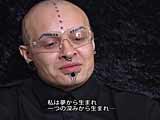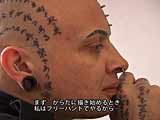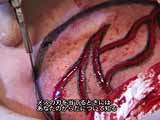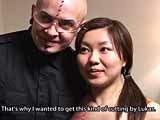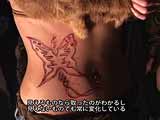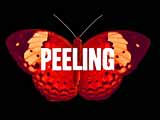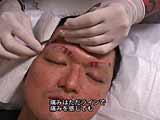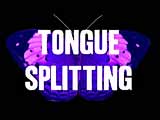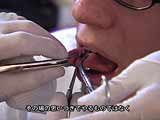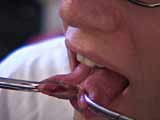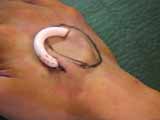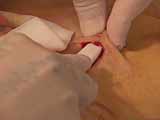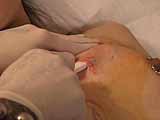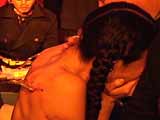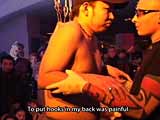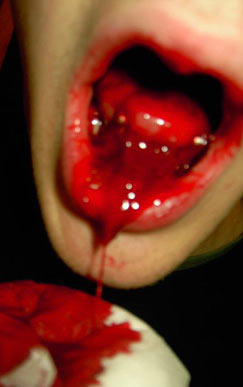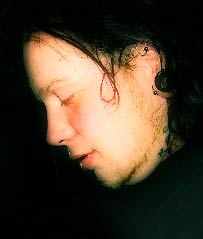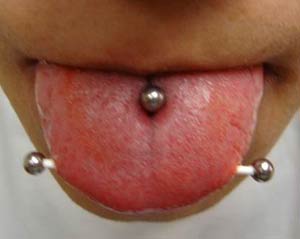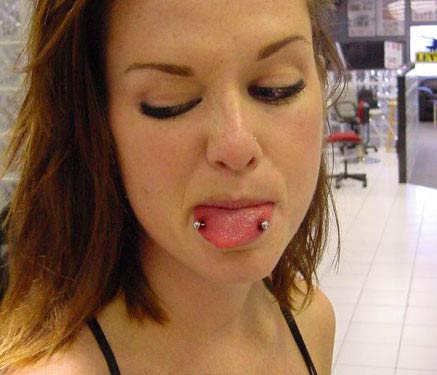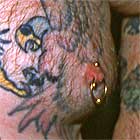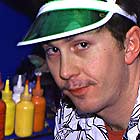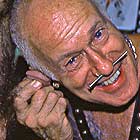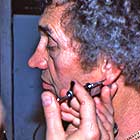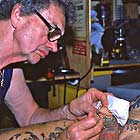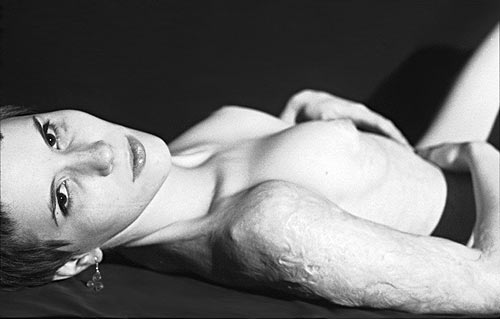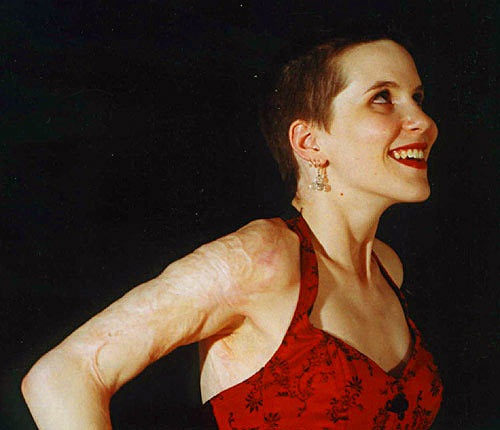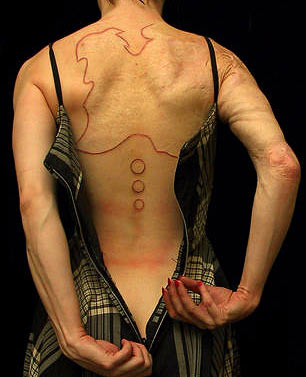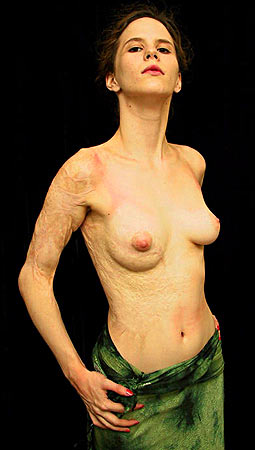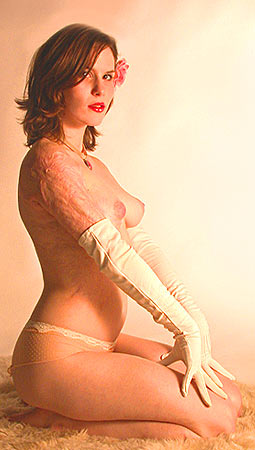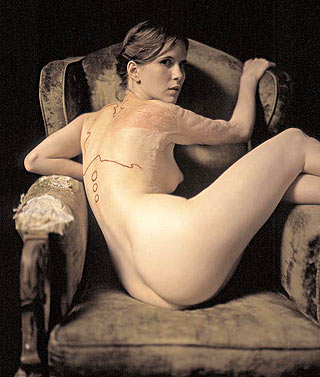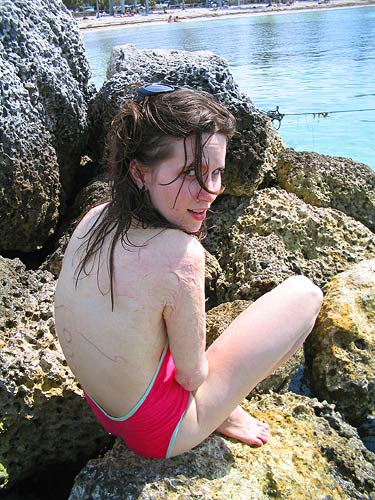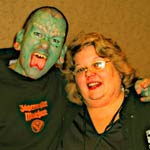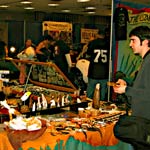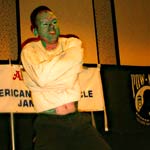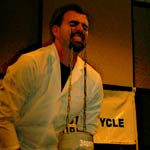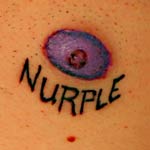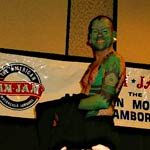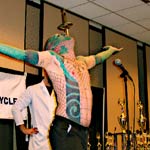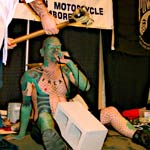 |

|
|||||||||||||||||||||||||||||||||||||||||||||||
|
||||||||||||||||||||||||||||||||||||||||||||||||
Author Archives: BME
Post navigation
Horizontal Tongue Piercings [Guest Column – Stepping Back]

EVERYTHING YOU EVER WANTED TO KNOW ABOUT |
“Growing up, I always had said that I would NEVER get my tongue pierced. I had always seen those trailer trash people on Jerry Springer, you all know the kind, and almost every single one of them had a tongue piercing. Seeing all of these trashy people on Springer, I associated being trashy with tongue piercings. I was determined not to get my tongue pierced and look trashy like all of those people.”
- Ashleigh,
Tongue Piercing with 20 People Watching
I love seeing people push their own personal boundaries. It’s great to see people do things without thinking of the consequences, or if they know about the consequences — they don’t really care. If anything, it usually makes for a good story afterwards. As long as there’s no chance of death, broken bones or paralysis, I’m all for people trying new things. Being in the body modification scene, I am a happy little voyeur and participant. I see all kinds of things that I wouldn’t necessarily try, but thanks to the internet, I learn something new every single day that I normally can’t learn through my daily activities.


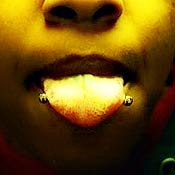
Most piercers consider these crippling and dangerous to the point of
being unviable piercings… But are they really impossible to keep?
Today’s lesson: people will put up with incredibly annoying piercings in trade for uniqueness. The specific one I’m talking about is the horizontal tongue piercing. It’s not very common, and probably for good reason. I’ve spoken to about a dozen different people who’ve gotten this piercing, and most of them complained about slurred speech (or at least a lisp), problems eating, biting down on the jewelry, a long healing period, and a lot of pain. The payoff? It looks really cool, and it’s a pretty unique piercing.
I chose to speak to four individuals in depth about their experiences with having a horizontal tongue piercing, and later a piercer that does them as well. If you just want the facts, scroll down to the bottom for a little FAQ on horizontal tongue piercings.
* * *
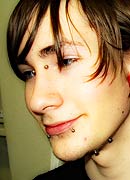 Piers de Burgh IAM:piersd, was nineteen when he got his done from Skin Graffiti in Swindon, England. He only kept the piercing for one or two weeks. |
 Pamela who no longer has this piercing, got it at Outer Body Experience in Castlegar, BC, Canada. She had the piercing for nine months. |
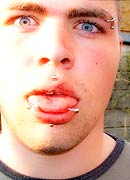 Gregg Bennett from England, had a friend of his do it for him when he was nineteen. |
 Steve IAM:Cenobitez, holds the record for this interview, keeping the piercing for nearly eight years. He got pierced at White Dragon in Stockport, Manchester, England. |
| BME: | What gave you the idea to get a horizontal tongue piercing? | ||
| PIERS: | I love to get unique piercings, and I hadn’t seen it anywhere before so it seemed like a good idea at the time. Vertical tongue piercings also are known to be sexual aids, so I thought that a horizontal one might be quite interesting too. The vertical tongue piercing tends to be very standard and is widely accepted now, yet if you simply rotate it, it becomes so much more. | ||
| PAMELA: | Well, I’m kind of the odd duck… I’ve always been into body mods. I had my navel done twice but my body rejected it both times before it had even healed, so I wanted something that my body would actually allow. I found BME and started looking around, and was immediately drawn to the horizontal tongue — I had never even heard of it being done that way — but I waited probably a good six or seven months before I actually did it. | ||
| GREGG: | To be totally honest I was going through a stage in my life where I had to be better than everyone else. The only problem that’s created when your friend thinks he’s a professional piercer and you can buy needles down at your local Wildcat shop? You end up with some weird and wonderful piercings!
I’d actually only been into piercing for about three months — before that I vowed I would never get one, and disliked them immensely. But then I saw an eyebrow spiral, got one, and was hooked. The vertical tongue piercing looked too boring, and a horizontal one seemed a good idea at the time. I’d been warned that you should never get a horizontal tongue piercing on a whim, so what do I go and do… I’m sure you can guess! |
||
| STEVE: | I already had a vertical tongue piercing, which was one of my first piercings, but I wanted something that was different and looked good. Then I saw a horizontal tongue piercing on a girl at Erotica, an adult industry trade show in London. After chatting to her I decided I wanted it done — I wanted something that I could say, “look what I got” because at the time, piercings were just starting to get popular. I have no spiritual or whatever reason… I just wanted it because it looked cool.
I searched the net and came up with a picture on BME. I took that with me to the piercer and when he eventually did it, he positioned mine as close to that picture as he could. I think mine’s pretty similar to his: |
||
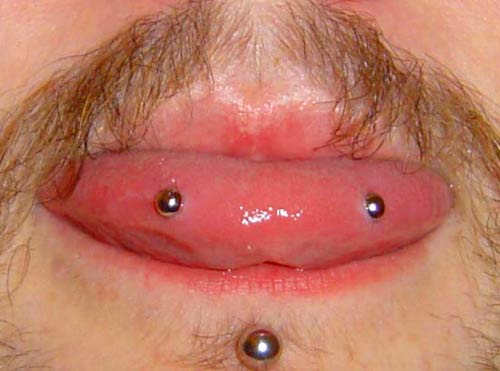 Steve’s Horizontal Tongue Piercing |
|||
| BME: | What factors did you think about when considering getting it done? | ||
| STEVE: | I thought about how it might affect my job, the potential for damage to nerves in my tongue. What if it were to hit one of those huge veins? I was considering all kinds of things about the possible damage to my taste buds and motor functions in my tongue, as it’s pretty deep into the tissue. I thought about potential speech difficulties, heavy bleeding, and at the time I had heard some rumors about tongue piercing implications with cancer and stuff. There was also possible dental damage, so I had a lot of health issues to consider.
The final factor it rested on was work. Would I be able to speak properly enough to do my job as a night club promotions manager — where it was key to be able to talk and chat to customers, and deal with businesses. |
||
| PIERS: | Tell the truth, I didn’t really think about the consequences. This was during my early days of piercings and I didn’t really listen to the warnings of trained piercers. | ||
| PAMELA: | Rejection was a battle with my navel and I didn’t want that going on inside my mouth, and then there was my mother: what she would say when she found out I did it? | ||
| BME: | Had your piercer done this piercing before? What did they think about your request? | ||
| PIERS: | I found out later, that Venom, my piercer, actually was very talented, but at the time I didn’t really care how experienced she was — as long as she would do the piercing!
She wasn’t nervous at all — probably more excited than anything. She explained about how it would swell, especially since I was having two in the same session (both vertical and horizontal ones), and talked me through how horizontal tongue piercings have a high chance of hitting something, or not lasting due to discomfort, and so on. |
||
| GREGG: | My piercer had never done it before. Having your friends stick holes in you really isn’t the safest option in the world, but at the time he had his own piercing studio and had all the proper sterilized equipment. | ||
| STEVE: | I knew my piercer had no experience with this kind of piercing, but he has a portfolio that included a lot of stuff I’d never seen, and he said he was always learning new stuff. However, initially he said “NO!” point blank. I called every piercing studio within a hundred miles and couldn’t find anyone else.
After a few months and a few piercings later I mangaged to talk him into it and he explained it all to me: the risks, the dangers, the unlikely issues, as well as the remote issues that would probably never happen, but he told me it all. |
||
| BME: | Since piercers often yearn to do unusual work, did you have to pay for the piercing, or did they do it for free or at cost? | ||
| PIERS: | I had agreed on a special price with her… I think I paid 30 pounds for both piercings I got that day [between $50 and $60 US]. | ||
| GREGG: | Mine was free. | ||
| STEVE: | I paid about ten pounds for mine [$20 US]. | ||
| BME: | What was the jewelry were you pierced with? | ||
| GREGG: | At first I had a 1.6mm — 14ga — PTFE barbell with PTFE balls so I wouldn’t smash my teeth on them. I later changed it to a metal barbell with metal balls, at the same size. | ||
| STEVE: | Originally the plan was to use what we had available — a one inch long steel barbell. However, when I worked it out, I figured it wouldn’t be able to rest it in my mouth due to the immense length, so we settled on PTFE and small 4mm beads on the ends so that they wouldn’t be too obtrusive and sit nicely in my mouth.
They’re now so unobtrusive that they can slide inside my tongue — I should actually put bigger ones on to stop that, but I think if I do, the hole where the current ball goes will stretch and I don’t want that. Now I have a one inch PTFE in it right with 4mm stainless steel balls on the ends. |
||
| BME: | How was the piercing itself done, and what did it feel like? | ||
| PAMELA: | OH! It was horrible! I was crying and begged her to stop halfway through. She told me she couldn’t, and then shoved the needle the rest of the way through my tongue. That is why if you look at it close enough it is crooked. | ||
| GREGG: | We did the piercing in a garden… I know you may consider this dangerous or dirty, but I felt safer being under the bright blue sky than in some room that resembled a doctor’s office. I wouldn’t advise anyone to follow me in this — this is just personal preference, and I’m sure most piercers wouldn’t do it anyway.
We decided clamping my tongue and going as fast as possible seemed like a good idea at the time, although my view now has changed and I would’ve preferred going slowly freehand, as this would increase the chance of getting a good straight line through my tongue. It felt rather unpleasant; the pain didn’t really abate from when the needle went in till the jewelry had taken its place. There’s a good twenty or thrirty seconds of pain in comparison with the mild discomfort of a tenth of a second that the average piercing gives you. |
||
| STEVE: | The week before doing the piercing we checked for veins and the likes with a torch (flashlight). The day of the piercing I got there with a few of my friends, waited a few minutes while he set everything up, and then he lead the way to the piercing room. I hopped up on the gurney and waited as he took a pair of large clamps out from the autoclave and dried them off.
He inspected my tongue again, and placed these clamps, made a few adjustments, and then locked them into place. He sprayed Xylocaine on my tongue, and then asked me to take deep breaths — which I was already doing — and placed the needle against my tongue. He slowly started to push the needle through, with the odd stop and change in direction and stuff to make sure it was straight, and then a last push and he was through. The pain was more of an intense burning, nothing like my normal tongue piercing. It felt like a small needle prick, then rapidly got hotter until it was stinging, and then felt more like it was burning as it went through. It felt like four or five minutes but I’m assured it was less than thirty seconds. |
||
| PIERS: | Mine hurt the most out of any other piercings I’ve had. It was closest to my medusa (top labret), just on sheer scale, rather than actually what it felt like. | ||
| GREGG: | Yeah, to say it hurt would be an understatement.
I looked straight up, watching the clouds roll by, and then a blinding sensation went through my whole face… Not unbearable, but certainly close to intolerable. I remember someone telling me to slow my breathing down or I’d hyperventilate. |
||
| BME: | How did you feel afterwards? | ||
| GREGG: | It looked great! I was so happy — I hugged everyone, washed my face, and did the best impression of someone with absolutely no use of their tongue… Worst lisp in history! | ||
| STEVE: | I washed my mouth out with ice cold water, and got a little relief. Then my piercer looked at it and said it looked damned good… I couldn’t talk or anything — I just mumbled and left his room and he told me to come back in a few days. As I walked out a few of my friends were waiting and they were like, “oh god I can’t believe you did that” and they were like “you’re mad” all the way to the pharmacy. | ||
 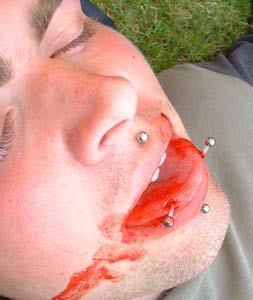 Pamela’s piercing not long before removal, and Gregg’s very fresh piercing. |
|||
| BME: | Did you change the jewelry during the healing process? | ||
| PAMELA: | About a month later when I went to a shorter barbell, I think an inch or an inch and a half. | ||
| STEVE: | I just clipped a millimeter (or four) off the PTFE bar and rethreaded it as the swelling went “up” not down, so my tongue actually got narrower and I clipped the PTFE to match. Once the swelling was gone I had to get another PTFE bar to replace it as it had returned to being wider. | ||
| BME: | What was the healing like? | ||
| STEVE: | The healing was very much like my other tongue piercing, only it took maybe six times longer. It’s now healed and I can take the bar out easily and replace it. It can still act up if I catch it or anything like that, but overall, it’s fine.
The only real issue I had during healing was eating bread or bread-like food, as it got stuck on the balls and hurt like hell, and that’s still a problem sometimes, but I think I have unknowingly adapted to that one. |
||
| PIERS: | To be honest, the piercing was very embarrassing, as it gave me a really bad lisp and I found it incredibly hard to eat. I had a constant lisp the whole time I had it in. It restricted my tongue from moving to pronounce the correct sound. It was very frustrating after a while. | ||
| PAMELA: | Well, it took about five months until I no longer had an infection or a swollen tongue in the mornings… but I toughed it out, lisp and all. | ||
| BME: | You had the lisp the whole time? | ||
| PAMELA: | Yes, I had a lisp until I took it out… After I took it out, it was another five months, when the tongue was fully healed, before my speech was perfect. | ||
| STEVE: | My lisp stopped as soon as the tenderness and swelling went down. I had a few issues with talking, but it was mainly with shouting. I still have those problems, but it’s a small price to pay. | ||
| BME: | Was there a lot of swelling in comparison to a normal tongue piercing? | ||
| PIERS: | I had both of them done at the same time so I wouldn’t know, yet when my horizontal piercing was taken out the swelling completely disappeared in a few days, so it kind of lead me to believe that most of the swelling was from the horizontal one. | ||
| PAMELA: | Yes, it was hard to talk for the entire time I had it because of the swelling, and I didn’t eat anything solid for over two weeks. | ||
| GREGG: | In my case there was hardly any swelling at all. | ||
| BME: | What kind of aftercare did you give it? Did your piercer suggest something special? | ||
| PIERS: | I’ve always just used salt water — it seems to be the most effective thing for me. | ||
| STEVE: | My piercer always suggests one part Listerine to three parts water, mixed into a water bottle, and I am to rinse after each meal and snack, and first and last thing in the day. | ||

|
|||
| BME: | Did your piercer warn you anything you’d have to look out for or be careful about? | ||
| PAMELA: | Actually, she didn’t. I only found out a month or so ago that the tongue is two muscles on the left and right side, and that it’s really bad for them to be pierced like that. | ||
| STEVE: | My piercer mentioned veins and nerves and other such things… one of the ones he was concerned about was the movement of my tongue — but I had thought about that beforehand and was pretty much determined to go through with it. | ||
| BME: | What’s the most annoying thing about having it? | ||
| PIERS: | The fact that I couldn’t smoke, eat, or talk properly. | ||
| PAMELA: | The lisp. I had a huge speech impediment. People who knew me well would always comment on it, but others that didn’t know me didn’t know if I had it before. I had problems with the healing on the right side of the tongue. I don’t know what happened there, but the barbell sunk into my tongue and in order for me to talk properly, the ball would have to be inside my tongue! | ||
| GREGG: | I had problems closing my mouth, eating, talking, chewing gum — pretty much anything orally. | ||
| STEVE: | The most annoying thing other than people always asking to see it, asking how long I’ve had it, and did it hurt — the usual things — is that it has a tendency to flare up over the slightest mistreatment. | ||
| BME: | On the other hand, what’s the best thing about it? | ||
| PIERS: | It looks amazing and it’s so rare. It’s getting very hard nowadays to get a piercing that is truly rare — don’t get me wrong, I love the fact that body modifications have become more widespread, but I just prefer having unique piercings and styles. | ||
| PAMELA: | I liked the fact that it showed my individual style, and that I do things for me and not for everyone else. The “Ahh cool”s were pretty sweet too! | ||
| GREGG: | It’s pushing your body beyond its normal state to create something you feel happier with — although this could be said for any piercing. | ||
| STEVE: | The best thing about this piercing is that it’s a defining piercing — when I attend IAM meets, and I do attend a lot of them, it’s the one piercing people identify me by, and I always get asked about it. Most people are surprised by the amount of time I have had it, and I have never met anyone else who has one or had one. I also love the shock value from the non-pierced folks at work! | ||
| GREGG: | You can’t really beat walking down the street with a bar going through the tip of your tongue (and peoples expressions)… Oh boy, did I get some expressions, from sheer horror to total respect and admiration. | ||
| BME: | Any problems with chipped teeth or other dental issues? | ||
| PIERS: | I only really thought about it after I bit down on one of the balls. Luckily no damage was done. I decided to move onto foods that only involved sucking or swallowing without chewing! | ||
| PAMELA: | I now have a big chip on my left front upper tooth that I want to get fixed soon. That is from when I would tighten the balls I would hold it there with my teeth.
I don’t think I had it long enough for major damage other than that one tooth chip to occur. For a while I used plastic balls, but they were internally threaded and would always break off. I got tired of that so I just went back to metal ones. |
||
| GREGG: | Not really. I am of that stupid breed of people who deem the piercing more important than the complications of the pierced party — however, my mind has since changed on the subject, and I would take a lot more into consideration over these sorts of factors so I didn’t do something I might later regret. | ||
| STEVE: | The only damage I got was when my bead came off while I was eating a hamburger, and I bit onto the bead and chipped one of my bicuspids. It’s a bit of a nuisance, but as it’s only a small chip, I don’t mind. | ||
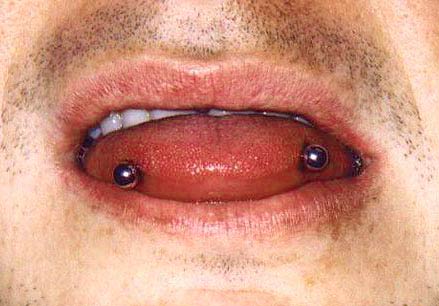
|
|||
| BME: | When you took it out, what were the factors in making the decision? | ||
| PIERS: |
I didn’t have a chance to rest the piercing. With my job I was constantly talking and shouting over the music in the club. One night I was working and I tasted a little blood in my mouth so I decided to go to the toilets and check it out. There was a slight bit of blood but I didn’t want to take any chances, so I went upstairs to the night club to pack up my camera and say goodbye to a mate on the bar. As I was trying to get out more and more people kept asking me to take their photos and dragging me further back into the club. By the time I got out it had started bleeding a bit heavier. I managed to stop it with pressure but a few days later while I was treating myself to a packet of smoky bacon crisps it started bleeding again, and quickly got worse and worse until I was spitting blood and some rather unpleasant blood clots. Even though I was reluctant, I knew it was time to take it out. When I finally did, I was really bleeding, and I made a phone call to a mate for a round trip to the local Accident & Emergency ward, as I felt like I was going to pass out. Doctors don’t really appreciate self-inflicted wounds so I ended up stopping the bleeding myself in the toilets. |
||
| PAMELA: | My lisp was probably the biggest factor. Biting on the balls, and one side didn’t heal properly. It just wasn’t worth it. | ||
| GREGG: | I removed mine because it wasn’t straight enough, and because of discomfort and annoyance at not being to talk properly. I only kept it for three days. | ||
| BME: | Steve, why do you think you’ve had so much success with keeping this piercing? | ||
| STEVE: | The key for me has been give and take. If I take the time to look after my piercing, it’s fine, but if I get careless, it’s problematic. If I mistreat the piercing it will swell. The secret is: make some changes and learn to deal with it, or you’re going to have problems. | ||
| BME: | What advice would you have for others thinking about this piercing? | ||
| PIERS: | Go for it! But if it was anything like mine, be prepared to change what you eat, how you eat, and how you talk. Hardcore body modification! | ||
| GREGG: | Do what you think is best — don’t rush something like this though, as it’s not something you should dive into without careful consideration of the consequences. | ||
| STEVE: | Give it serious thought because there is the risk of dental damage, muscle damage, nerve and vein damage. | ||
| BME: | Do you consider this a viable piercing? | ||
| PIERS: | I know one girl with it in the area I live in, and she’s got pictures of it healed so why not? Just because it didn’t work for me doesn’t mean it won’t for you. | ||
| GREGG: | Perhaps in the future, but why take the risk of harming the way you speak? Your speech is the way other people can recognize the being that is you, and if you have nice teeth and can’t afford corrective dentistry, then why take the risk? | ||
| STEVE: | For me, absolutely. If for some reason this has to come out or starts to migrate I will remove it, heal it, and get it done again. | ||
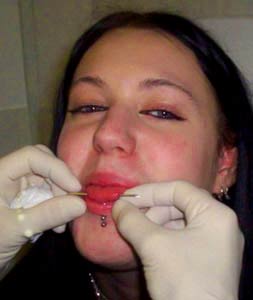 
|
|||
| BME: | Was it all worth it? | ||
| PIERS: | It was definitely worth it. I still consider this to be a very beautiful tongue project. The only reason I took it out was because of the bleeding. To tell the truth, I don’t regret any of my piercings, but this is definitely a piercing that I would like to have again. | ||
| PAMELA: | Honestly, no, it’s not. The five months healing time alone was crazy on my part. Every morning I wanted to take it out, but I always wondered, “what if it’s so cool when it’s healed?”
Well, it was cool when it was healed, but then the lisp and all the other problems made it suck… but if the one side didn’t pull through I probably would have kept it! |
||
| GREGG: | If you’d have asked me this question two years ago I’d have told you it was all worth it and I was getting ready to have it repierced, but in hindsight, I don’t think it was worth it, but it depends on your mindset. Too many young people get a piercing to be different, and too many piercers do piercings like this to show they’re on the edge of their science. In the big scheme of things it isn’t worth it to damage other parts of you for the sake of being unique, although it just depends where you draw the line. | ||
| STEVE: | I have worked my way into two managerial jobs with two mainstream companies with my piercings and all. One of them is my main job in a night club called “Heaven and Hell” in Stockport. I am the first line of contact with the public and even with my piercings, I have the job, and I have worked my way up the ladder.
I would sacrifice my livelihood over it though, and I almost did when I went to claim unemployment — I refused to take it out and they could have refused my benefits but I showed them my resumé and proved I can and will get work. It’s definitely worth it, purely because after nearly a decade of having it, it’s still a rare piercing, and not many people can say they have that these days! |
||
|
Giving us the story from the other side of the needle is Matt Bruce (IAM: modsbymatt), an active piercer at Body Jewellery and Piercing in Victoria, British Columbia. He’s performed several horizontal tongue piercings, and turned away even more customers asking for it. He’s here to tell us, from a piercer’s point of view, some of the most important things to know about the piercing.
|
|||
| BME: | What kind of cautions do you need to take that are different than a normal, vertical tongue piercing? | ||
| MATT: | I researched this one for a while, thinking I was missing something, but it seems that as long as the blood vessels taper off before the area you are piercing in, it tends to be hassle-free. | ||
| BME: | What kind of jewelry do you use, and why? | ||
| MATT: | I use PTFE barbells because they bend with the movements of the tongue itself. A stainless or titanium barbell will only get in the way while trying to talk and eat and such, and Tygon has to be changed too often. I prefer to use PTFE beads as well but if they want stainless, I just make sure the jewelry is short enough that the beads sit inside of the teeth. | ||
| BME: | Can you explain the process of making sure the customer is suitable for the piercing and of doing it? | ||
| MATT: | Like I said, as long as there are no obvious blood vessels in the area, that’s a good start. I find that if they fold up the tip of the tongue and at the fold there is an indent on either side than they have good anatomy for it, but that doesn’t mean they are good for the piercing.
Good oral hygiene and previous experience with piercing and oral piercing is a must, and then, based on all those variables, I decide from that point if I will do the procedure. If everything is a go, I make my entrance and exit marks and then brace the tongue with a piece of gauze in-between my thumb and first fingers. After everything is lined up, I push the needle through to the other mark and then follow through with the jewellery. |
||
| BME: | Do you warn the people about possible dental damage or other potential problems? | ||
| MATT: | Of course. As a professional piercer it is my obligation to inform people of any possible negative effect that any procedure could have on the client. | ||
| BME: | How much should customers expect eating, drinking, talking, and so on to be affected? | ||
| MATT: | They will find it awkward at first, the same as any other tongue piercing, but with PTFE it makes it very easy to adjust. Usually at the two week point they tend to be talking well and the distension is almost completely gone. | ||
| BME: | What advice would you have for others thinking about this piercing? | ||
| MATT: | Make sure you see examples of the piercing in the artist’s portfolio that you approach and I would say that if they recommend a metal barbell, then I would look somewhere else. Also, just because this or any piercing has been done does not mean it can be done on you. If someone turns you away because you do not suit the work you want don’t just keep looking till you find someone that will! | ||
| BME: | Do you consider this a generally viable piercing? | ||
| MATT: | That is a hard question to answer. For some, a navel piercing isn’t viable, for others a standard tongue piercing isn’t. I try and just go person-to-person with every procedure I do. If it is viable for that individual then I do it. | ||
|
|
|||
With a little bit of pain and persistence this piercing is possible. You’ll need an experienced piercer that understands not just the right to do the procedure, but understands why the piercing has to be this way. Otherwise you risk permanent humilation from not just a lisp but the diet of a level six vegan — nothing that hasn’t been put in a blender. It’s very rare for good reason, but still might be the right piercing to get if you understand the risks and want something unique. Try it if you dare, but don’t say I didn’t warn you.
|
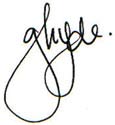
– Gillian Hyde |
||
|
||
Spreading the Word and Remembering Sailor Sid [Running The Gauntlet – By Jim Ward]
 IX. Spreading the Word and Remembering Sailor Sid A huge part of Gauntlet’s success was probably the result of the tireless effort I put into promoting, not just the business, but body piercing itself. Over the years I traveled regularly giving presentations to everything from S/M organizations to university human sexuality classes. A lot of people take it for granted that they can go into almost any tattoo shop and get a body piercing. Believe it or not, that has not always been the case. To some of us it seemed self evident that tattooing and piercing go together like salt and pepper. But there was a time when many tattooists were outraged at such a suggestion. Having a personal interest in both and knowing many others who shared it, it seemed logical to me that the tattoo community was just waiting to embrace my efforts. It didn’t take long for me to find out otherwise. Early in 1977 the International Tattoo Artist’s Association (ITAA) was having a convention in Reno. In an effort to reach out and spread the word amongst the tattooed, Doug suggested that I get a vendor booth there. I submitted the necessary forms and was accepted. This would be one of our first appearances in public.
I made up an assortment of jewelry and gathered a selection of piercing equipment and set off with Eric and Doug for Reno. We were greeted by a number of familiar faces. Cliff Raven and his lover were in attendance as was our friend Tattoo Samy from Frankfort and his wife Ella. We also met Ed Hardy who was doing very extensive tattoo projects on a couple of members of the T&P group. Fakir was present and had been asked to provide entertainment at the banquet.
Outwardly everyone was courteous and curious. During the course of the convention a number of people made arrangements to come to our room for private piercing appointments. Among them was the girlfriend of Dale Grande who had done tattooing with Cliff Raven when he had his shop in Chicago. I was even asked to do a nipple piercing demonstration on the floor of the vendor area. A good looking young tattooist named Steve Richards volunteered to be my subject. The demonstration went well, and many people stopped by the Gauntlet table to ask questions. On the surface it appeared we were well received. But unknown to us there was trouble brewing. A number of the big name tattooists, among them Ed Hardy, were not pleased.
Fortunately not all tattoo organizations were as hostile as ITAA and NTA, but the Reno convention was the first and last tattoo event that I recall Gauntlet ever vending at. For years to come the applications for at least some conventions carried a statement reading in effect that, “we will not rent vendor space for piercing or anything else that might give tattooing a bad name.” This is pretty much a direct quote. What I would love to have pointed out, but never did, was that bad tattooists were far more likely than we to give tattooing a bad name. This attitude toward piercing persisted with some tattooists for a decade or so. Then in the late 1980s when the popularity of body piercing exploded, some savvy tattoo artists realized there was money to be made doing piercing. Almost overnight there was a huge shift in attitude, and tattooists around the world began setting up shop as piercers whether they were qualified or not. The following April another tattoo convention was to take place in Texas. Although vending was no longer an option, Doug and I planned on going to hand out business cards and meet people and promote our favorite form of body adornment. Plans were progressing well until shortly before we were to leaving for Texas. Doug approached me and said that after giving it some thought he felt it wasn’t worthwhile and that instead we should take a vacation to Key West and then go up to Fort Lauderdale and spend a few days with an outrageous piercing and tattooing enthusiast, Sailor Sid. I took him at his word and didn’t think anything further about the change of plans. Later it came out that the real reason for the diversion was that Doug had learned his youngest son Robert would be attending the Texas convention and that he wanted to avoid running into him. We flew into Miami, rented a car and took to the road 160 miles south to Key West. I particularly remember the series of bridges that link the chain of small gulf islands with the mainland. We passed through Key Largo, an easily forgettable place whose name at least we’ll always remember thanks to Bogart and Bacall. It’s funny how memory plays tricks on us. When I first started writing this article it seemed like Doug and I had made only one trip to Key West. But when I began looking through photos and examining the dates stamped on slide borders, I realized that we had actually made two trips to that sunny destination.
In truth much of the memory of this trip is pretty sketchy. I’ve no recollection whatsoever of the hotel where we stayed. I do recall doing many of the usual tourist things. We explored all the usual tourist traps on main street. I still have a hand made silver belt buckle we bought on this trip. We visited the home of Ernest Hemingway and lunched at some roadside shack on the beach where we ate stone crab — the first I’d ever tasted — simply prepared, fresh, and delicious. Doug also hired a boat for us to have an afternoon and sunset Gulf excursion. I still have the slides we took. Doug had a personal connection to this Southeastern tip of the United States. He told me that the island might well have belonged to Cuba, but in 1821 an ancestor of his had purchased it thus making it part of the US.
One of the sites we took in was an old fort that had been turned into a museum. In one of its many rooms we came across a portrait of John Simonton. After our Key West venture came to an end we loaded up the rental car and headed north to Fort Lauderdale to spend a few days with the self proclaimed “freak nut” who went by the name Sailor Sid Diller. 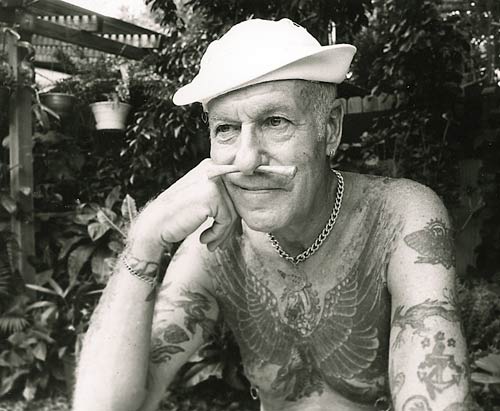 Sailor Sid in a photo I took of him in 1980. To say that Sid was a character is putting it mildly. Generally speaking I think he was a kindly and good hearted person. He could be a source of endless humor although he had a tendency to repeat the same joke or bit of business often to the point of painful irritation. I found him to be genial for the most part, but after spending some extended periods of time with him, discovered he could be quick-tempered, irritable, and occasionally petty especially where money was concerned. From my perspective he was a difficult man to get to know and warm up to. The freakish side of his persona was always on display. It was a façade that was firmly in place, and he rarely allowed anyone to see the real person behind the mask. Sid was in his late sixties when I first met him. He had been fascinated with tattoos from the time he was preadolescent. Sid had been a member of the Coast Guard which, during World War II, was a part of the Navy. It was in those war years, the early 1940s, that he got his first piercings — ear and frenum — and tattoos. If memory serves me correctly he became an electrician after leaving the service and settled down in Ft. Lauderdale, Florida where he retired. Sid’s passions were tattooing, piercing, and very heavy S/M. He had managed to connect with a large number of other enthusiasts throughout the world and was a voracious correspondent, writing at length — on a typewriter, no less — about his experiences. Photos of his exploits and those of others were often included. No doubt BME enthusiasts would hardly find them shocking, but for their time these included some of the most extreme S/M I had ever seen documented, including extensive play piercing scenes and some involving opening the scrotum and exposing the testicles. 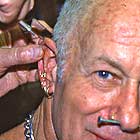 Doug piercing Sid’s ear. Doug’s and my visit did not include any of these particular activities. Sid took us to a gay bar or two — pretty tame ones by LA standards. He also arranged a big piercing party at his home for various gay friends and fellow motorcycle club members so they could drop in and get pierced.
At this point in history the Jim Ward name didn’t mean very much in piercing circles. Sid didn’t really know me, and his assumption seemed to be that Doug would be doing a lot of the piercing. Aside from acquiescing to Sid’s desire for a piercing or two from the hands of the “Master,” Doug very graciously sang my praises as his protégé and made it clear that I would be doing whatever piercing services were required.
|
I pierced at least eight people that night, some having multiple piercings. Doug got into the spirit of the evening by letting me pierce his ear. Being as closeted as he was, it came as no surprise that he removed the jewelry by the time we returned to LA. Sid got his wish when Doug added another piercing to his ear and gave him an apadravya. The atmosphere was congenial and supportive, and everyone seemed to leave on an endorphin high.
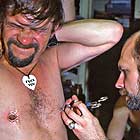

During our visit Doug and I also met a kinky straight friend of Sid’s named John. My impression was that John enjoyed cross-dressing or at least expressing the feminine side of his nature. Both legs were tattooed with lace stockings made up of hundreds of tiny spiders. His toenails were painted. In many of his piercings he wore jewelry of a decidedly feminine character. John was probably the first man I ever encountered who had split the head of his penis. It wasn’t difficult to understand why he and Sid were friends.

Sid’s kinky straight friend John,
perhaps the first man I ever met with a split penis head.
Our stay in Ft. Lauderdale was pleasant, and we returned to LA having made many new piercing friends.
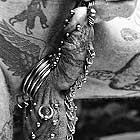
A closeup of Sid’s genital piercings taken during my 1980 visit.
I visited Sid again in 1980 to interview and photograph him for PFIQ. That interview appeared in issue #10. I’ve never considered my skills as a photographer to be particularly outstanding, but I have to say the pictures I took of Sid are among the best I’ve ever done. He was relaxed and open and never camera shy. The photos I took that day always remind me of one of the most unforgettable characters it’s been my privilege to know.
Sid kept two collections of personal papers that I know of: the correspondence and photographs he’d accumulated over the years relating to tattooing and piercing. When he died May 24, 1990 — age 80 if my calculations are correct — he had already made provisions for his collections to go to people he trusted. I believe he left the tattoo papers to his good friend Jack Yount. I’ve no idea what happened to these after Jack’s death. The piercing collection Sid left to me. A few months after his death a couple of large, heavy boxes arrived for me at Gauntlet’s corporate office. In them were a number of three-ring binders filled with photos in plastic protectors, not to mention a large stack of correspondence. Not only were there many letters from his various and sundry friends, but oddly there were photocopies on thermal paper of many letters Sid had written to them.
For some time I pondered how best to preserve this unique collection and also make it accessible to interested individuals. I considered using some of the material in PFIQ, but since there were no photo releases, and I didn’t know most of the individuals pictured or how to contact them, I abandoned that idea.
As time went by my health became somewhat uncertain, and I was forced to face the fact that I might not have that many years to live. I was concerned about the future of the unique collection Sid had left in my care and felt the best thing I could do was to find a better home for it. Eventually I made the decision to donate it to the Leather Archives and Museum in Chicago. It’s clear from their web site that the collection is still there. I’m assuming anyone interested in exploring this resource can make arrangements to view and study it.
Sid was one of a kind: a man who marched to a different drum and made no apologies for it. Despite any differences we might have had, I consider myself fortunate to have known him.
Jim Ward
http://www.gauntletenterprises.com/
IAM members click here to discuss this article.
| Jim Ward is is one of the cofounders of body piercing as a public phenomena in his role both as owner of the original piercing studio Gauntlet and the original body modification magazine PFIQ, both long before BME staff had even entered highschool. He currently works as a designer in Calfornia where he lives with his partner. |
Copyright © 2005 BMEzine.com LLC. Requests to publish full, edited, or shortened versions must be confirmed in writing. For bibliographical purposes this article was first published March 29th, 2005 by BMEzine.com LLC in La Paz, BCS, Mexico.

Taking it to the Next Level [Guest Column – Stepping Back]

Not only accepting the fact that she’s severely scarred for the rest of her life, Montreal-based professional linguist, performer, and model Ella (IAM:ella) is celebrating it. And by celebrating it, I mean showing it off. And who can complain about a hot girl who shows off her body? Up until several years ago though, Ella didn’t show off: She did everything to avoid people seeing the scars left by a pot of boiling water falling on top of her at age four. She wore long sleeved shirts the majority of the time until age eighteen, hoping that the questions and ridicule would stop if people couldn’t see that she was any different than them. It worked the majority of time, and that made her happy until, during her teenage rebellion stage, she decided she was going to show the world what she really looked like, and the long sleeves disappeared.
Expecting an “OH MY GOD” reaction from everyone who came into contact with her, she was disappointed to find that very few people seemed to care. Her attempt at a “‘fuck you’ rebellion thing” seemed to go totally unnoticed. There are events in our lives that can change our perception of ourselves, our lives, and the world. Ella’s paradigm shift was caused by someone — her then boyfriend — who not only accepted her physical differences, but found beauty in them. The point of view seemed contagious, and Ella’s attitude towards her scars changed. She too began to see them as beautiful; she started to see them as a good thing. Shortly after that, she began modelling. Her ex-boyfriend was good friends with Jerome Abramovitch of Chapter9Photography, and they did several photo shoots together. Modelling proved to help her become even more comfortable with the way she looked, and soon she moved onto doing burlesque shows at a fetish club run by a friend of hers. She later progressed into television, where she was featured in seven out of thirteen episodes of Kink III, on the Showcase channel. Talk about celebrating your differences. Amina Munster (IAM:Amina Munster), who I interviewed in February 2005, is planning on coming out with her secret to her SuicideGirls public within the next couple of months. As a child she nearly drowned, resulting in the loss of the fingertips on her right hand, a quarter of her right leg, and half of her right lung. Amina has done a fantastic job of hiding the fact that she is missing parts of her body in real life and online where she’s an active and popular SuicideGirl. She’s soon ready to join Ella and celebrate the fact that her body is different than anyone else’s. In preparation for an A&E show called “Inked,” who decided to feature Amina on an episode, she had her prosthetic leg airbrushed to look tattooed. In the near future, Amina will show her online fans that she’s not who they thought she was by doing photo shoots that don’t hide her missing leg. She’s hoping for the best, of course, and expects even more positive feedback, much like the comments she got from the people of BME after the article featuring her was published. The main difference between these two girls is that Ella considers what happened to her as a child as “body modification” whereas Amina does not. Another outcome of Ella’s paradigm shift was that she decided to highlight her scars with scarification: a testament to the fact that she loves how her body has been changed.
Kudos to Ella. Not only has she accepted what has happened to her, she’s dealing with it in the most positive light. It’s admirable to see someone whose strong body matches a strong mind. She’s a role model for other people who have gone through similar traumatic experiences, she shows people that there’s nothing to be ashamed of, regardless of the level of scarring or deformation that someone has. There’s a strong difference between simply accepting what your body looks like and actually falling in love with its changes. Intentional modifications or not, Ella’s body is beautiful. Visit Ella at cicatrix.net or on BME’s community site as IAM:ella. – Gillian Hyde |
|||||||||||||||||||||||||||||||||||||||||||||||||||||||||||||||||||||||||||||||||||||||||||||||||||||||||||||||||||||||||||||||||||||||||
|
|||||||||||||||||||||||||||||||||||||||||||||||||||||||||||||||||||||||||||||||||||||||||||||||||||||||||||||||||||||||||||||||||||||||||
Waivers and Releases for Tattoo and Piercing Studios [Legal Link]
Above are sample release forms for tattoo and piercing studios. If you use them, get them reviewed by local counsel first. You may want to edit them to include more (or less — but CYA) risks and medical conditions, or make other changes to suit your studio’s needs.
Waivers can protect studios from suit for all different kinds of potential harm, such as infections, scarring and keloiding, allergic reactions to ink or green soap, a kanji placed upside down and, my favorite, misspelled tattoos The simple fact of having signed a waiver and release can discourage many clients from seeking to sue you in the event of a problem. Similarly, a client who goes as far as to talk to a lawyer will find that most lawyers will turn them down as a client if there exists a well-written waiver and release — unless the circumstances are particularly nasty, the lawyer won’t view the case as worth their time and effort. And in the event you do end up in court (or even small claims court), the client’s executed waiver and release will be a strong defense.
GOOD PRACTICE TIP: In the case of spelling a tattoo, it is always a good idea to have the client print out themselves the names or words to be spelled — a good location for this is the back of the waiver or release and have the client initial the spelling.
For clients of piercing and tattoo shops, this means you must be well educated in the risks of the trade and accept those risks before signing your rights away. You always have the option of going to another studio with no waiver to sign or to one that is less restrictive on limiting liability. Or simply don’t get the mod.
KNOW YOUR LOCAL LAW
Laws differ from state to state, city to
city, county to county. Thus, writing any kind of overview of US law is like
hitting that fifth hour of a non-stop tattooing session — it’s outright painful.
(I speak from experience on both counts.) But unlike getting a backpiece, where
the only thing to do is just deal with the pain, here I can lessen the legal
load by providing my own CYA clause:
Get a local lawyer to draft or at least review the free sample waivers provided in this article (Perhaps get other shops nearby to share this cost with you). Do not rely solely on this article as legal advice. A waiver and release that does not take into account the specific laws applicable to where your shop is located may not be any protection for you at all. Instead, feel free to think of this as just learning something new to sound smarter at dinner parties.
With that off my shoulders, let’s
get under the skin of tattoo waivers and releases.
Most US states will enforce a waiver or release, although some hold them to a more rigorous standard than others. And at least three states — Louisiana, Montana, and Virginia — have deemed waivers against public policy unenforceable, according to “Liability Waivers” an article on waivers for the health and fitness industry by Dr. Doyice Cotten, co-author of Waivers & Releases for the Health & Fitness Club Industry. The eight states that are most lenient in upholding waivers are Idaho, North Dakota, Michigan, Alabama, Georgia, Tennessee, South Carolina, and Maryland. While Cotten based his research on sports-related waiver cases, the findings could be analogized and extended to tattoo and piercing waivers.
Other states have their own peculiarities. In California, for example, an express waiver of the provisions of Section 1542 of the Civil Code may be necessary to obtain a waiver and release that is effective against future claims. It is standard practice in California for a waiver and release to contain a provision such as the following:
(If you are a resident of the State of California) I agree to waive the provisions of Section 1542 of the Civil Code of the State of California, which provides as follows:
A GENERAL RELEASE DOES NOT EXTEND TO CLAIMS WHICH THE CREDITOR DOES NOT KNOW OR SUSPECT TO EXIST IN HIS FAVOR AT THE TIME OF EXECUTING THE RELEASE, WHICH IF KNOWN BY HIM MUST HAVE MATERIALLY AFFECTED HIS SETTLEMENT WITH THE DEBTOR.
I understand that section 1542 gives
me the right not to release existing claims of which I am not now aware,
unless I voluntarily chose to waive this right. Having been so apprised, I
nevertheless hereby voluntarily elect to, and do waive the rights described in
section 1542, and elect to assume all risks for claims that now exist in my
favor, known or unknown, from the subject of this Waiver and Release. I
acknowledge that I have had the opportunity to consult with legal counsel of
my own choosing and to have the terms of this Waiver and Release fully
explained to me; that I am not executing this Waiver and Release in reliance
on any promises, representations or inducements other than those contained
herein; and that I am executing this Waiver and Release voluntarily, free of
any duress or coercion.
GOOD PRACTICE TIP: Know the laws that apply to you. Many states, cities, counties and local munincipalities now regulate tattooing and piercing in some way. You should get a copy of these statutes for your reference and keep them in your shop as well as provide them to any artist working in your shop. And don’t rely on these laws as to not change. Tattooing and piercing, as it has become more mainstream, has attracted greater attention-and motivated some people to seek greater regulations and restrictions on it from restricting who, what and where a person may be tattooed to zoning laws on where you shop may be located. It’s your responsibility to stay up on changing laws that may affect you. It’s much easier and effective to counter an attempt at increased regulation of your profession before such laws are enacted [But that’s for another article.]
NO DRUNKS AND MINORS
Whether your state court will enforce the waiver or release is going to depend on who is signing it. “Capacity” of the person getting the tattoo or piercing is key, according to attorney Ronald D. Coleman of the Coleman Law Firm and general counsel of the Media Bloggers Association. He says:
“At least as important as any issue having to do with the text of the release form is that the tattoo shop owner must be confident that the person getting that tattoo is not impaired and is an adult. [This is “capacity.”] It is not enough for the release form merely to recite the fact that the person signing it contends he is not impaired; if the tattoo shop owner’s own non-expert observation suggests an impairment, this term of the contract likely will ‘not be worth the paper it’s printed on.’ As a general rule, the law will uphold substance, not form.”
What this means is, if a person staggers into your shop drunk, reeking of whiskey, and asks for a Britney Spears portrait tattoo on his chest — even if he’s willing to sign away all liability — he just may come back and sue you when he sobers up and possibly win. “Oops, I did it again” is not a valid legal defense.
Less obvious, a client who speaks fractured English may not be bound by a waiver or release that is written in English. So, if you have a clientele that speaks Spanish, for example, it would be a good idea to have on hand a form of release that is written in Spanish.
It also means that an attractive young woman who could easily pass for 18 years of age and wants to pierce her navel must still provide ID showing she’s the age of consent for this type of piercing in your state. The R. Kelly “she looked 18” excuse just wont cut it unless there’s proof or a parent around.
GOOD PRACTICE TIP: Photocopy the ID’s supplied by the client and parent (if applicable) and attach to the copy of the waiver and release you keep on file. Educate yourself to be able to spot a fake ID or driver’s license as well — and if you are in doubt as to its validity, turn the client away!
Which raises the question: Can parents, signing a tattoo or piercing release form on behalf of their child, thereby, sign away their child’s rights to any damages arising from the procedure?
The answer is yes and no. Again, it all depends on the state, city and county in which your shop is located.
Looking at cases where parents have signed releases for horse riding or ski lessons, cheerleading practices, and a variety of sporting and extracurricular activities, the courts are divided across the US on whether to enforce waivers signed on behalf of minors. For example, a Washington court refused to uphold a ski school’s release even after the mother of a child who was injured during ski lessons signed the agreement releasing the school from any liability for negligence. That court held that parents generally do not have the right to waive their child’s own future action for present injuries sustained from a third party’s negligence. Yet, in a similar case in Colorado, that state’s high court upheld a waiver signed by a parent of an child injured while skiing and found for the defense.
This Colorado case and many other cases that have upheld waivers and releases signed by parents for their minor children cite the 2000 Supreme Court decision of Troxel v. Granville for the principle that “the interest of parents in the care, custody, and control of their children is perhaps the oldest of the fundamental liberty interests recognized by [the US Supreme] Court.”
Therefore, having a child’s belly button pierced is a right that many parents have — as noted, for example, in Connecticut, under General Statutes sec. 19a-92g, explicitly permitting a parent to consent to body piercing of an unemancipated minor child. Just keep in mind that not all state legislatures are as evolved as Connecticut’s.
GOOD PRACTICE TIP: As a general rule, it is probably not a good idea to tattoo a minor — even with a parent’s consent, unless you know the parties very, very well. Whereas a piercing is “temporary”, a tattoo is more permanent and difficult to remove if the wearer or parent later regrets the decision. So, why risk it?
GET THE LANGUAGE RIGHT
Even those state courts that uphold releases
are still going to check to see if the waiver or release is properly drafted.
[While I attempted to make the sample agreements as detailed as possible, they
cannot be considered properly drafted until signed off by an attorney
knowledgeable of your local law.]
The problem with many releases is that they are overly broad. Tons of Internet sites offer free legal forms, but I have yet to find one that fully covers the specifics of tattoo and piercing studios.
I did find one that made me laugh on Overlawyered.com that was created by tattooist Pat Fish. In Pat’s release, she also includes the line “I am not a lawyer, nor do I work for one.” For those lawyers that want ink from Pat, she makes them circle the provision and next to it write “But I am ashamed.”
Clauses for professional self-loathing aside, waivers should be specific as to what is involved and what can go wrong. If you own a studio that provides both tattoo and piercing services, have a separate release for each, and have each list their specific risks. For example, the samples provided in the article include risks such as scarring and infection. You could modify the samples so as not to scare away your clients, but like I said, it’s all about CYA.
Another CYA clause, is one that requires the client to properly care for the tattoo or piercing while it’s healing. But Robert Coleman points out that this provision is “fairly worthless if [the client] has not been properly instructed in that care.” He adds, “It is a good idea to give the customer written instructions on care and for him to sign a separate receipt proving that he received them.”
GOOD PRACTICE TIP: Aftercare instructions should be clearly posted on the wall in the studio in a visible and conspicuous place. Each client should receive a printed copy of aftercare instructions BEFORE commencing the tattoo. Upon completion of the tattoo or piercing, the artist should review the aftercare instructions with the client and ask if there are any questions. Keep a pile of aftercare instructions available in the studio’s lobby/waiting area for clients to take with them.
Coleman also favors considering an attorneys’ fees provision in waivers, requiring the loser of any litigation to pay the other side’s attorneys’ fees and costs. “This will certainly discourage meritless litigation. On the other hand, the risks here are fairly obvious.”
An artfully drafted release or waiver with a host of specific provisions on tattooing or piercing is a great line of defense against potential law suits, but the courts will also look to make sure that the client actually read the agreement and understood what they were signing. In my sample waivers, there are lines next to each provision for the client to initial. They are also drafted in clear language, and in readable font, so that you don’t need a law degree or a magnifying glass to read them.
GOOD PRACTICE TIP: Reproduce your waiver and consent form in easily readable type and preferably on a single sheet of paper (printing it on the front and back if necessary) so that the signature is never separated from the waiver itself.
NEGLIGENCE OR GROSS NEGLIGENCE
You’ll also find a provision in my sample
specifically releasing the studio from liability for their own negligence. Some
states, including New York and Delaware, among others, require such language
waiving claims arising from “fault” or “neglect.” Other states don’t require it,
but it may not hurt to have it.
Negligence is failure to exercise due care — care that a reasonable, prudent person would exercise under the same circumstances. On the other hand, gross negligence is the failure to use even the slightest amount of care in a way that shows recklessness or willful disregard for the safety of others. While in some cases ordinary negligence can be waived, gross negligence or intentional misconduct cannot. So what does that mean for tattoo and piercing shops? Where is the line drawn between negligence and gross negligence? No US cases were found where the courts look at this line in the context of tattoo and piercing shops, but we can make a guess for the following scenarios:
- Answering the phone and not changing your gloves before touching the client again?
Could be ordinary negligence - Dropping your needles on a dirty floor and then using them on a client?
Sounds like gross negligence. - Tattooing or piercing too deep so as to cause scarring?
Maybe ordinary negligence.
- Tattooing or piercing while drunk or high no matter the outcome?
Probably gross negligence.
Whether a court agrees with these guesses is the real issue — it depends upon an examination of the facts in each circumstance, and a court’s ruling may vary from state to state, county to county. The important point to keep in mind, however, is that no waiver or release can protect you from claims of gross negligence.
GOOD PRACTICE TIP: Do not assume use of a form of waiver or release to absolutely protect you from any claims. It is your responsibility in your shop to institute procedures for all artists and employees to follow to assure that the laws you are subject to are complied with and that procedures to assure the sterility and safety of the application of all tattoos and to prevent the cross-contamination of instruments, surfaces and materials (pigments) is scrupulously followed.
WAIVERS DO NOT COVER ILLEGAL ACTIVITY
According to the basic principles of contract
law, you cannot enforce a contract for illegal activity. Then again, the client
who also engages in the illegality may have little right to sue as well.
With the exception of Oklahoma (which is currently reconsidering its state-wide tattoo ban), tattooing and piercings are legal in the US. However, waivers for heavier modifications, such as tongue-splitting, explicitly outlawed in some states, and other mods that fall under laws prohibiting their practice, including practicing medicine without a license, cannot be protected. Performing these modifications may open you up to criminal charges of assault and battery or worse. Some lawyers may also tell you to ask yourself whether you want to have a document attesting to a potentially illegal activity anyway. But you didn’t hear that from me.
For legal waivers, however, hold on to those documents. The safest bet is to keep them filed away until the statute of limitations for any potential law suit has expired in your state. A statute of limitations is a law that prevents a person from bringing a claim after a fixed period of time has passed — irrespective of the validity or worthiness of the claim. With respect to personal injury, most states require a claim be brought within two years — but that time period may not start to run until the person is aware of the injury giving rise to the claim.
GOOD PRACTICE TIP: Retain copies of releases in a safe place for a minimum of three years, and if practicable, even longer. While statutes of limitations may be only two or three years for most claims likely to be brought, in some instances, the statute preventing a claim may not even begin to run until the person knows that they have a claim against you. For example, if the claim results from your publication of a client’s photo without consent, the statute will run only from the date of publication — which could occur years after the initial tattoo was completed.
Finally, the best advice on waivers or releases: don’t rely on them alone to protect you. As Coleman emphasizes, “Insurance, insurance, insurance!”
GOOD PRACTICE TIP: Understand insurance! If the shop you work at has insurance it may cover the shop-but not you individually as an artist!
And with that comes some sound CYA advice.
Marisa Kakoulas
This article was not intended as legal advice. It is intended for only general information purposes. This article does not create any attorney-client relationship.
Special thanks to Rebekah Harris for her invaluable help in legal research and editing.
Marisa Kakoulas is a New York lawyer, writer, and muse of Daniel DiMattia of Calypso Tattoo, living in Liege, Belgium. She works undercover — or just covered up — as a corporate consultant: proof that tattoos and suits are not mutually exclusive. Her book “Tattoo Law”, an overview of US laws affecting the body modification community, is under way. IAM members can visit Marisa at iam:FREE.Copyright © 2005 Marisa Kakoulas. Online presentation copyright © 2005 BMEzine.com LLC. Requests to republish must be confirmed in writing. For bibliographical purposes this article was first published online February 27th, 2005 by BMEzine.com LLC in Johannesburg, South Africa.
SPIRIT+FLESH: THE ENERGY PULL (PART 1) – Fakir Rants & Raves
 |
Spirit+Flesh: The Energy Pull: Part I |
|
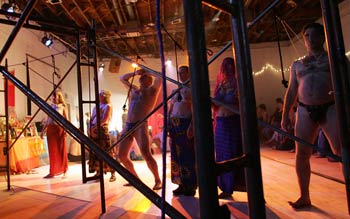
Fakir’s Spirit+Flesh group energy pull and ritual
in Minneapolis, June 2004.
So What’s an Energy Pull?
I first experienced the “energy pull” when I was only about twelve years old (way back in 1942). Being the weird kid that I was, I had already discovered I could pierce needles and pins through my body with impunity — that I could get into a head space where I was a mere witness to cold steel passing through my flesh. In this state of mind I was removed from physical sensation, what the rest of the world called “pain”. But after I had pierced myself, there was no further sensation. Only a static needle stuck through me. It did not hurt. I couldn’t feel it. It was just there.
So wanting to expand my emotional experience, I soon learned to tie a small string around the needle and pull on it. I could pull gently and gradually increase the tension. I was in control of how fast and how much sensation I was receiving. Soon I learned to tie the string to a hook in the wall and pull back against it. I loved doing this and it became a regular practice for me. Every time I did this, I experienced a sweet rush of energy. At this time in my early life, I didn’t analyze what I was doing or try to rationalize it. I just enjoyed it.
In my teens, I lived in libraries (there was no internet for another forty years) and I devoured books. I was very curious to know more about the practice of piercing and pulling. I didn’t take long before I found out that what I was experiencing in my secret basement hideaway was not unique. Piercing and pulling was, in fact, a very ancient and honored practice in several cultures. I learned that in Savite Hindu Culture, they had been doing this kind of body ritual for at least 3,000 years. For them it was a technique for trancing, going beyond the body, leaving the body and allowing the body to be temporarily possessed by higher spirits and archetypes (like Murugan, Lord of Piercing). It was not a display of strength or macho or stoicism or an entertainment. It was the seeking of “a state of grace”.
Even closer to home for me (because I grew up on Indian lands in South Dakota only a few miles from Indian ritual grounds) was the Native American pierce-and-pull ritual called the “Sun Dance”. I didn’t need to study books to learn more about that practice! I had some first hand access to the stories and tales of Native American elders in my own community. I listened to them in the flicker of kerosene lamps as they talked in hushed tones about the glories of the “old days” when Sun Dance was the way to the Great White Spirit. Of course when I was a boy, the ritual had long been made illegal for Native Americans and they could be put in prison if caught secretly doing a Sun Dance. My heart ached for them to be denied the practice of one of their most sacred rites! I guess so far we Modern Primitives are very lucky that what we do has not been made, in most cases, a prisionable offense!
“It’s not how hard you pull, but how long…”
That phrase was a mantra used by Ogallala Sioux medicine men when they were instructing young men before doing a Sun Dance. What most contemporary hook pullers do not seem to understand about this practice is the complex interaction between body and spirit. When one does an “energy pull”, one is manipulating and rearranging the connections between body and spirit. Sure there are physical and chemical changes like the release of the body’s natural opiates, the endorphins. But there is more to it than that. At first there is the sweet rush, euphoria. Some of you know how that feels. But if the pull is prolonged, in concert with strong shamanic intent, there can also be intense visions, healing, travels to unseen worlds, going to core and touching the void. A few of you may have even gotten there. It is not about “trucking” or “tugs of war”.
Since the revival of the Sun Dance in modern times (starting in the 1970s), many of the Native American elders who direct the energy pull called the Sun Dance have noticed and bitterly commented on the conflict they see in some young dancers between traditional Native and Western European values. Western culture, with its focus on competition and individuality, clashes with traditional values of surrender, patience, group energy and letting go of ego. In some recent Sun Dances, young dancers were seen to compete with each other about how hard they could pull, how fast they could break free, how quickly they could be done with the dance. In the old days, a Sun Dance was frequently arranged so whatever the dancer was tethered to could only bend and resist the pulling. Breaking free of the piercing(s) was made impossible. The length of time one could pull against piercings was the truest measure of worth and devotion — and a great way to reach unseen worlds.


Left: 1830’s George Catlin drawing: prolonged energy pull by Ogalala Sioux against a springy sapling. Right: Fakir does three-hour energy pull during 1982 Wyoming Sun Dance and O-Kee-Pa ceremonies seen in the Dances DVD.
Any meaningful energy pull is not about pain, macho, testosterone or stoicism. It is rather a way of slowly increasing and prolonging the tension until one enters an altered state. In traditional Native American Sun Dances, pulling on piercings was not minutes or even hours, but often days. I personally know several recent Sun Dance pledgers who were pierced and pulled for four days! In Penang Malaysia I saw devotees who pulled on their multiple back hooks from five in the morning till eight at night — 15 hours! In my own experience (see the Dances Sacred & Profane DVD) Jim Ward and I pulled for some three hours before opting to break free. As the Ogalala medicine man said, “It’s not how hard you pull, but how long”. That is what makes the difference between a momentary thrill and a truly memorable and life transforming experience.


Tamil Hindus do day-long energy pulls from multiple hooks. Photos taken by Fakir during the 1995 Thaipusam Festival in Penang, Malaysia.
Opening Fourth Chakras
This brings me to the chapter in my life that began about 1987. Until that time, it was inconceivable to me that anyone else, except Jim Ward, might want to try what I was doing. My first volunteer was my life partner, Cleo. She had lost many friends and lovers in the AIDS epidemic that had begun in the early 1980s. She was filled with grief and heart-centered pain. So at her request, I made a ritual out of piercing her upper chest and back — then attaching balls to tug and pull with every movement. She danced for hours up and down a dusty path on a hillside in Northern California. On each side of the path we had placed stakes with photos of sick fiends, dying friends and those who had passed beyond the veil. She cried. I cried. And we both felt a release of heart-centered pain and grief at the end of the afternoon. I called that ritual a “Ball Dance”. It was then I began to realize the therapeutic effect of tugging and pulling on piercings, especially in the fourth (heart) chakra.
Over the following years, we repeated our piercing rituals and introduced them to many others in the subculture. In 1990, a group of us “ball dancers” got ridiculed and laughed at during the first gathering of Black Leather Wings. Some of the Leather Daddies present dismissed our ritual as a silly and trivial event. A few years later, we met with greater acceptance in Dallas, Texas where Allen Falkner hosted a large “Ball Dance” event that even got mentioned in the newspapers.
During the 1990s, I started experimenting with hooks in the chest (fourth chakra) instead of lighter piercings with attached balls or limes. I found them far more effective in opening the fourth chakra and releasing “stuck” energy. So beginning in 1996, I introduced the “hook pull” to various groups of seekers in the subculture.
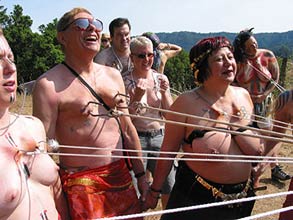
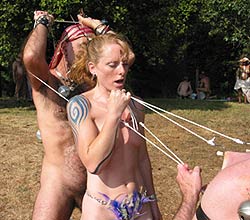
Group energy pulls during day-long BLW rituals in Northern California, 2003/2004
Over the next nine years, the practice of pulling on flesh hooks spread from my first groups of only five or six people to the large number of hook pullers you can now see in the photos posted on BME. However, there is a difference between the hook pullers you see in photos on my Spirit + Flesh web site, and I suspect, most of those in the BME photos. In our shamanically-directed hook pulls we are very conscious of chakras — those important energy centers related to the body that open, close, and change energy flow in both our psychic and physical world. Of all the chakras, the fourth one, the heart chakra, is the most screwed up in our culture. It is the gateway from lower consciousness (survival, self, base emotions) to higher consciousness (love, clear mental activity, inclusiveness, selflessness). If it is blocked and full of crap, we live in world of confusion and misery. We live primarily as victims and make bad decisions. Read some writings of Caroline Myss for more on this. Actually, I wish we could compel our U.S. politicians (especially you-know-who) to participate in a shamanic hook pull and then send them to Caroline Myss.
With this insight, and what I feel was a strong nudge from my Patron Saint Lord Murugan (Hindu Lord of piercing and opening up), we have been doing public Sprit + Flesh Workshops & Rituals for about five years now — with repeat rituals in San Francisco, Los Angeles, Washington D.C., Phoenix and Minneapolis. My partner and I consider these workshops and rituals a humane and needed service more than a vocation. Obviously, we still focus on opening the fourth chakra, and sometimes chakras above number four. But I don’t see much point in doing knee or elbow pulls because there are no chakras there to open, close or manipulate.
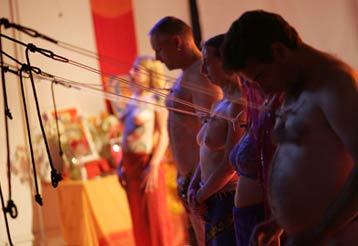

Trance states and the opening of heart chakras was the intent and purpose of group energy pulls in this 2004 Minneapolis Spirit+Flesh ritual. See my web site at fakir.org for participant feedback.
Cleo, My Partner in Spirit + Flesh Rituals Says:
“I have been doing this ritual many times now. Every time it has been a different journey. The whole exploration for me is about altered states, a heightened state, energy, fire (yes it can be really hot), and visions. Most especially if I am pulling alone against a stationary object with my eyes closed. Any awareness of others or spectators quickly disappears. It is a personal dance of ecstatic fire, bright or soft. I went several times to a place that is not a place. Beautiful!”
“My last hook pull ritual was like wringing my heart from its grief. During the second stage it was a very sexy, a big energy exchange with my puller/lover. The third phase was fun and releasing as I pulled in a big circle with other dancers. You connect intimately with friends, lovers and even strangers pulling on your cords, tuning in to each other, experiencing group energy in a ceremonial tribal ring. At the end I was laughing and very high in this pool of energy and fantastic live drumming.
”
In the second part of SPIRIT+FLESH: THE ENERGY PULL, I would like to take you on a guided tour of some of the more memorable experiences we’ve have had, even in our next ritual which is only one week away in San Francisco. I’ll include some more photos and also feedback comments from energy pull participants. And if hook pulls must be entertainment, at least they can be “art” as my friends Vaughn and Joey Wyman of Body Manipulations did a few years ago. We’ll get into that and more in my next column.
Yours for safe and enlightened journeys,
![]()
Fakir Musafar
fakir at bodyplay dot com
|
For much more information on Fakir and the subjects discussed in this column, be sure to check out his website at www.bodyplay.com. While you’re there you should consider whipping out your PayPal account and getting yourself a signed copy of his amazing book, SPIRIT AND FLESH (now). Copyright © 2005 BMEzine.com LLC Requests to republish must be confirmed in writing. For bibliographical purposes this article was first published February 25th, 2005 by BMEzine.com LLC from Los Angeles, CA, USA.
|
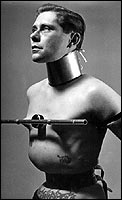 |
Missing Parts [Guest Column – Stepping Back]

|
“One sees clearly only with the heart.
Anything essential is invisible to the eyes.”-Antoine de Saint-Exupéry, Le Petit Prince
When your physical appearance changes against your will, like scarring or losing a limb, is it considered body modification? I’m not just talking about accidentally slicing your finger open while cutting a watermelon, or burning your arm on a stove rack, but rather, severe circumstances like what happened to Ella Earp-Lynch (IAM:ella), who was burned by a pot of boiling water at age four, or to Amina Munster (IAM:Amina Munster) who had her leg amputated and the tips of her fingers fall off as a consequence of nearly drowning before the age of two.
Ella, who has scarring on nearly a third of her entire body, says that she absolutely considers what has happened to her as body modification. And why? “The disingenuous answer would be to say, ‘because my body is modified from the way it originally was, it’s different from the way it was at birth’.
  Amina and Ella |
But I can also say that I first started thinking of my scars as body modification when I began to see the beauty in them, and to feel that having them made me more, rather than less attractive.”
These women interpret their experiences in very different ways. Ella showcases her modifications, and even highlights them with Dremel and scalpel scarification and branding. This decision was easy for her, and began when her friend, “a scarificationist, mentioned that he thought that the small scar on my left shoulder looked like a bird, specifically, like a Chinese phoenix, and said that he would like to try and “bring it out” with a technique he had been experimenting with using a Dremel tool to
abrade the skin. This started me thinking, and I realized that herein lay the solution to my problem — I had always wanted further mods but had had a hard time figuring out how to incorporate tattoos with my extensive scars.”
“Another part of what I like about my current project (of modifying/outlining my existing scars and eventually mirroring their outlines on the other side of my body with more conventional scarifications) is that I feel it reflects my attitude towards my scars more accurately to the average person, and makes it easier for them to see what I see.”
Amina, on the other hand, hides her “modifications” both in real life and online, where she is an active and popular Suicide Girl.
She debuted on SuicideGirls.com in late December 2002, and she has never shown her missing leg or fingers in any of her photos. She’s fairly heavily tattooed, has a gold tooth and breast implants, all of which she considers mods, but does not consider her “missing parts” body modification. She believes that in order to classify something as body modification, it needs to be an intentional act.
Why the gray area? Intentional amputations happen, accidental amputations certainly happen more often — but when is it considered body modification? Is it simply in the eye of the beholder?
I decided to interview Amina to find out what it is exactly that stops her from classifying the accidental changes to her body as “body modification.”
  Amina Munster |
|
|
BME:
|
What happened to your leg and your fingers? |
|
AMINA:
|
When I was seventeen month old I was left home with a babysitter because I had a fever. Instead of the babysitter watching over me and my five year old sister, she decided to call her friends and invite them over for a pool party. Believing that I could swim, I left the playroom, went outside, stacked up laundry baskets to climb over the pool gate and jumped in the spa that the babysitter had been heating up for her friends. The babysitter never found me, my next door neighbor heard my sister screaming at the spa. It was the neighbor who took me out of the water and called the paramedics.
My leg was lost due to loss of circulation and oxygen. My right leg was amputated below the knee. My fingers were left to fall off by themselves. When I was sent home, the tips of my fingers were black and dead. The tips gradually fell off by themselves. Resulting from this accident I am missing a quarter of my right leg, the tips of all five fingers on my right hand and half of my right lung. |
|
BME:
|
Did anything happen to the babysitter? Was she charged with any criminal acts? |
|
AMINA:
|
My parent’s home owners insurance paid for the hospital bills and a hefty settlement. My parents decided not to sue anyone. When I turned eighteen, I was told by my parents that I had the option to sue anyone I wanted including my parents, the babysitter, the hospital, or the babysitter’s parents considering that she was seventeen at the time of the accident. I decided to not sue anyone; the accident happened so long ago, isn’t the expression let dead dogs lie? |
 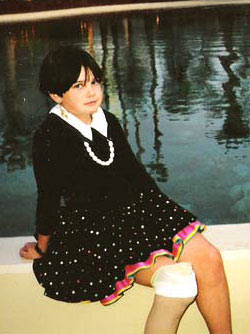 Amina’s black fingertips before they eventually fell off, and her amputated leg. |
|
|
BME:
|
Why did you become a Suicide Girl? |
|
AMINA:
|
Honestly, I have loved models and modeling since I can remember. I grew up looking at the Varga girls and 50’s style pin ups. Suicide Girls was like a breath of fresh air to me. I thought that it was amazing to find a place where girls were considered beautiful and had piercings and tattoos. I became a Suicide Girl just to try something different and I will never regret it. |
|
BME:
|
Why did you decide not to show your leg or your fingers in your photographs? |
|
AMINA:
|
When I had originally applied to Suicide Girls years ago I decided to keep the leg, or lack there of, a secret. I felt that SG would not accept me to be a model if they knew I was an amputee. Throughout the years it has gotten difficult to keep coming up with creative ways to cover my prosthetic leg, however, I still have not been able to shoot the mermaid set that I have dreamt about. |
|
BME:
|
Who takes your photos for SG? |
|
AMINA:
|
Currently all of the sets that I have up on Suicide Girls were shot by a friend and Missy, the owner of SG. However, recently I was able to shoot two sets with Steve Prue, who I greatly adore. |
|
BME:
|
Did your photographers try to convince you to show your leg? |
|
AMINA:
|
I have worked with many photographers and I have never felt pressured to show my leg. I did recently take a series of photos displaying the temporary prosthetic leg, but that was at my request. I love this leg because you can see the insides, it looks bionic. |
  Her leg and fingers are always hidden in her pictures for Suicide Girls |
|
|
BME:
|
Are you planning on showing the online public that you have amputations? |
|
AMINA:
|
Right now I am wearing a temporary prosthetic leg. My other leg is currently getting airbrushed at the Hart and Huntington Tattoo studio in the Palms Hotel and Casino, they have an A&E show called “Inked” that covers the daily activities of the tattoo shop. My leg and I will be featured on that show. I honestly do not know what the artist is airbrushing on the leg other than a big Virgin Mary on the calf. After I have received the completed leg and have finished filming for ‘Inked’ I will be shooting a set for Suicide Girls exposing the airbrushed prosthesis. It will be the first time that it will be shown on Suicide Girls that I am an amputee. Should be interesting. |
|
BME:
|
Is the airbrushing just for the photo shoot or will the paint stay on the leg permanently? |
|
AMINA:
|
The leg is getting airbrushed to look like traditional tattoo work. The paint will permanently stay on the leg and I think I may mount it in a glass box when I am no longer able to wear it. I’ve had plans for many months now to expose the leg on Suicide Girls, I just thought it would be cool to show it looking tattooed. The artist and I both decided on traditional art work, very Sailor Jerry…but with no swallows or flames. I left the majority up to him. |
|
BME:
|
Do you have any fears about the people’s reactions? |
|
AMINA:
|
To tell you the truth, the general public on SG may not know about my prosthesis, but it is certainly not a secret. Rumors fly over that website all the time, people like to talk. Even many girls whom I consider to be good friends still feel the need to tell members or anyone interested in SG that I am an amputee. It is truly funny that when peoples own lives stop being interesting that they choose to talk about someone else.
When it is finally shown to the SG community that I am an amputee, I really expect for most people to be shocked. I hope that it will show them that people with missing parts are beautiful too. I really don’t expect outrage, but I’m sure I will get the occasional ‘that’s gross’ comment.
It’s very hard to offend me, as I’ve heard it all before. |
|
BME:
|
So far, what has been the feedback on your presence on SG? |
|
AMINA:
|
I have met many girls off of SG who are now some of my best friends. I even met one of my tattoo artists off of SG, he agreed to tattoo me in exchange for three of my baby prosthetics. Naturally I am considerably popular on Suicide Girls due to my many tattoos and the fact that I show my boobies. But I am unsure if that will all change when my amputations are exposed. |
|
BME:
|
What brought you to BME? |
|
AMINA:
|
A friend and fellow Suicide Girl, Twwly told me about BME, I checked it out and fell in love. |
|
BME:
|
How long have you been tattooed? |
|
AMINA:
|
My first tattoo, if I remember correctly, would have to be the Winnie the Pooh outline on the inside of my left ankle. This tattoo was done when I was 15 in my bedroom by my first boyfriend. Of course at such a young age we did not have a tattoo machine and instead used a safety pin. This tattoo has been left untouched all these years as a reminder of my first love.
Since then I have been tattooed by many talented artists including Eric Maaske, Tim Kern, Tim Hendricks, Jim Miner and Chummy. I started getting real artwork by established artists when I was seventeen. I walked into Classic Tattoo in Fullerton, CA with my court papers proving that I was an emancipated teen and Eric Maaske agreed to work on me. My first tattoo on my arm was a pirate girl with a peg leg, some think it to be a self portrait. |
|
BME:
|
Is it actually a self-portrait? |
|
AMINA:
|
Technically it isn’t, but I did have her peg leg be on the right side to match mine. |
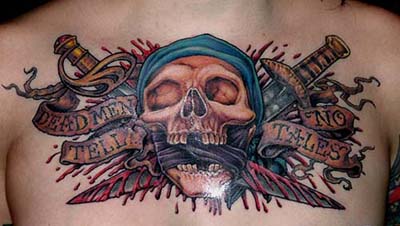 Chest Piece by Tim Kern |
|
|
BME:
|
Does being an amputee impact your decision to get tattoos? Do you have any tattoos relating to your amputations? |
|
AMINA:
|
The only tattoo that I currently have directly relating to my amputations is the Pirate girl by Eric Maaske on my right arm. But I do have future plans for more. When I began getting tattoos on my arm I placed all of them on my left arm thinking that it would take attention away from the right side of my body. It would be a sham if I didn’t admit that. It worked, and when I shook hands with someone they would be so preoccupied with the tattoos covering my left arm that they wouldn’t notice the missing fingers on the hand that they were shaking. Since then I have moved on to tattoo my left arm and chest, and I am no longer trying to cover up my disability with tattoos.
I have found that other people with ‘missing parts’ tried to do the same, so it is not uncommon. |
|
BME:
|
Do you consider your amputations as “body modification” as they weren’t intentional? |
|
AMINA:
|
Since my missing parts were not intentional I do not consider them ‘body modification.’
I think modification would have to do with the direct and intentional act of modifying something. Ha, I didn’t intentionally modify my leg, it just kind of fell off. I would, however, consider my white gold tooth as a modification. Although I did not intentionally knock it out, I did choose to replace it with white gold and not a replica of the latter, and unlike most people, I do consider my breast implants to be a modification. |
|
BME:
|
How did you loose your tooth? |
|
AMINA:
|
I blame losing that fucker on the leg. I have such bad balance. I was very intoxicated in San Francisco back in April of 2004 I drank some liquor that I will refer to as ‘the devil’ at the Budda Bar. As soon as last call hit, I traveled out onto the street and attempted to walk off of a curb. My attempt was ill fated. I fell flat on my face busting my lip and eye, and knocking out my front #10 tooth at the gum line. |
|
BME:
|
Why did you choose to replace it with white gold? |
|
AMINA:
|
The second that I was informed by three different dentists that the tooth replacement was going to set me back a whopping $3,000 bucks I knew that I wasn’t going to get a replica of what I had just knocked out. It turns out that if you knock out just one tooth at the gum line that you have no other alternative than to get a single dental implant, so I got the white gold as a treat to myself. Plus I find frontal gold teeth on men very, very sexy; I just don’t know more than one guy who has them. Bring on the men with gold teeth! |
|
BME:
|
Any specific or unique reason why you wanted breast implants? |
|
AMINA:
|
Not to be too blunt, but I love boobies and I love breast implants. Add that to the fact that I was as flat as a twelve year old boy. I got them June 4th of 1999, and still no regrets. |
 
Unintentional vs the Intentional |
|
|
BME:
|
What kind of feedback have you gotten from IAM members? |
|
AMINA:
|
I have had nothing but pleasant encounters with fellow BME members. I do get a lot of questions about how I lost my leg and fingers, but that’s just natural curiosity. I guess I should have an explanation somewhere on my page, but I don’t want my missing parts to define who I am. I don’t want someone to visit my page and just see information about my leg, there is much more to me than that. |
|
BME:
|
Do you find real life people more accepting than online people, or vice versa? |
|
AMINA:
|
The only place that I have shown my prosthesis online is on BME. Since I usually wear pants and never have my leg exposed in real life, I do not really know what the general public’s reactions would be. Other than some people noticing that I may be limping a little one particular day, it is rare that any one would ever think that I have one leg. I have never had a problem finding lovers, most men just don’t care. Although I do have that ‘Deuce Bigelow’ fear of not telling a man beforehand that my leg is a prosthesis and then watching it fall off in his hands. Now that I think about it, my friends and I have played many jokes similar to that one on unsuspecting targets. |
|
BME:
|
Why do you keep it a secret? |
|
AMINA:
|
If you’ve done something for so many years it just becomes routine. I would be delusional if I ever thought that my lack of a right leg could ever be considered a secret. My story seems to be something that people like to tell at cocktail parties. More often than not, when I meet someone that knows anyone that I do, they already know of my amputations. I kept it a secret on Suicide Girls possibility to be accepted or just to be one of the girls. Instead of Amina the amputee, I am just Amina. I wear pants daily because it is simply less of a hassle. Although online I could write a story and paste it on my profile that will hinder repetitive questions, I cannot walk around daily with the story taped to my chest. I will be showing it soon on Suicide Girls because I can no longer remember any reason to keep it hidden. It is what I am and ultimately makes me who I am. |
|
BME:
|
What do you think of people who intentionally amputate their fingers or other body parts? |
|
AMINA:
|
I will not ever say that it is disgusting or gross or that I do not understand it. Since I was a child I have wanted to amputate one of my toes, not because I would like how it looks but for more aesthetic purposes. I’ve always hated that my toes touch, as everybody’s toes do. I just always figured that by eliminating that one toe between my middle toe and my pinkie toe that the problem would be resolved. So I myself have considered voluntary amputation. I’m sure most people do it for different reasons, like cutting the bad parts out or eliminating something you prefer to be without. I know someone that voluntarily amputated a body part and to this day I still do not know the reasons that person had. But it was their choice, not a common or accepted choice, but a choice that person is very happy with.
If I had two legs would I prefer to have one amputated? No, never. I would never wish that upon someone who did not wish it upon themselves. Why? Simply because it is a hard existence. Not just because of the jokes, ridicule, stares or innocent questions, as that could not possibly be any less of I’ve had to learn to walk fourteen times in my life, my prosthesis cost up to $20,000, and if I decided to drop some weight for health reasons, I have to get another leg. The shape of the stump changes with every couple pounds I lose. Since May of 2002 I have lost twenty-one pounds. However, I have only had two legs in that time. Some days my leg will be black and blue from walking, some days I can’t walk. Sometimes I wish that I could walk for more than eight minutes without giving my leg a rest. My knee is half the size as my other knee due to atrophy, very similar to the Chinese women who wrap their feet, and my knee never had the chance to grow beyond a juvenile’s size. Sometimes I envision my bone growing through the end of my stump as it did twice when I was younger. Also, because I am currently without health insurance, and if it were not for my Prosthetist being a good friend of mine, I’m sure that right now I would be without a prosthesis. I have heard the saying “God only gives you what he thinks you can handle” many times. And if I believed in God I think I could find some peace in that. |
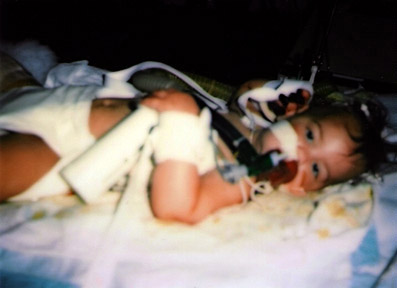 * * * |
|
Certainly, if I break a fingernail or get a bruise on my leg, I would not consider it body modification nor body art. I guess, ultimately, it’s up to the people who have unintentionally injured their bodies to classify any changes as “body modification” or not. Regardless of whether it’s by choice or accident, these girls’ bodies are different than what they’re supposed to be. Everything after that is left up to interpretation. Who really needs the labels anyway?

– Gillian Hyde
typealice
|
Gillian Hyde (iam:typealice) is a vagabond, though her roots run deep into Nova Scotian soil. She’s lived and worked on three continents since 2001, and has never lived anywhere for longer than eight months since the age of 16. She loves fonts, puns, being barefoot, and office supplies. “Calm” to her is the roar of the ocean. Online presentation copyright © 2005 BMEzine.com LLC. Picture of Ella by Warren Baird. Front page picture of Amina taken by Steve Prue. Requests to republish must be confirmed in writing. For bibliographical purposes this article was first published online February 9th, 2005 by BMEzine.com LLC from La Paz, Mexico. |
 |
Lizardman Q&A #9 [The Lizardman]

Number nine… number nine… number nine… number nine… number nine It never ends. Since it was a Shannon inspired question that made me do it this month, let’s start with him.
|
|
How do you deal with overly aggressive fans that start to border on stalkers, or try to put emotional demands on you? |
Fortunately, I haven’t had too much of this thus far but when it does happen it can really shake you up. What I mostly get are people who seem to mistake general politeness and kindness on my part as an establishment of a deep friendship that somehow obligates me to them. Sadly, this seems to arise out of many people just not being used to having someone show any interest or simple decency towards them. I do my best to try and explain that just because I will listen and make some simple effort to help you (like providing information) that doesn’t make us best friends, I do the same for most everyone. I really am a misanthrope but I am optimistic enough that I try and golden rule my way through most situations in hopes of reciprocity.
|
And to get it out of the way since someone always asks: “What are the spiritual elements of your modifications” |
Repetition is one of the cornerstones of marketing and education (think about that), so it can’t hurt to say it again:
The Lizardman is an atheist who firmly believes that any and all spirituality is a mental construct at best and ultimately a crutch which must be discarded as false and limiting!!!!!
There is nothing spiritual about me or my modifications nor can there be.
|
As a person who makes their living based in part on the mystique and fantasy of their persona, do you ever worry that being “too real” or “too accessible” could negatively affect your career? Do you ever feel that maybe you should “act more like a celebrity”? |
Oh to act more like a “celebrity” — and get away with it. Isn’t that the dream? If being “real” or “accessible” is what puts someone off, then is losing them really much of a loss? I do try to act like some celebrities, but I am selective about it. I look at people like Kerry King and some of the others I have worked with and see them as good models for handling people with respect and openness regardless of any celebrity status.
 |
My wife (IAM:Meghan) is not going to be Lizard Woman. She does have her own very interesting theme going though, all based around urban legends.
|
 |
I had plenty of moments of doubt early on, which is why I took so long to get going with it but once I got started each piece made it more and more right. I have never gotten any feedback that made me question doing it; it was only ever a matter of getting past my own reservations. I am the only one that can make me worry or regret and in terms of my modifications I am past that. The wonderful thing about doing something for yourself is that while you can consider other people’s opinions, they are mostly irrelevant.
|
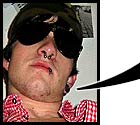 |
You seem to say it in a bad way but I do get special treatment now and then but almost always in a nice way. I am a very obvious non threat to most security personnel and as such I often pass by fairly easily. They are often curious though and will ask me lots of questions, even going so far as to take me out of lines and such to do so — but often this means I get expedited through the rest of the process, which is an advantage. Many security personnel remember me, especially at airports due to my frequent travel and I get greeted politely and treated better than average — which can often annoy the straight-laced businessman fumbling with his shoes while being patted down since I just stroll by.
|
 |
I don’t want children, so I don’t want them educated. The children may be the future but today belongs to me!! (The Simpsons)… Since they will have no bodies, modification is non-applicable.
Israel doesn’t scare me in the least. I would gladly go there given the opportunity. Seeing some of the historical sites of the Middle East and walking on the great wall remain two of my very few unfulfilled travel ambitions.
|
 |
My wife will actually mock you even more so than she does me. You having the 650 actually helps me divert attention from what she sees as my gadget fetish and overindulgence in technology. If there is one thing I can count on, it is Meghan not leaving me for anyone with a phone that isn’t some sleek tiny silver flip model that is only a phone, instead of the promethean gift which is TREO.
And yeah, I was damn good on X-files. Did you see how well I played the role of ThEnigma? Wardrobe did fantastic with the color change.
|
 |
Historical revision questions are hard because lots of the option now only exist because of what was made known to be possible as a result of Busino and others. If I was just a person now looking to get my tongue split I would likely still go to a doctor but if I was me with the people I know I might opt for a cutter due to personal trust and knowledge of their work. I always recommend doctors first because they are better trained and equipped for emergencies (at least any doctor I would trust) and it helps avoid legal issues and potential community fallout in the event of problems.
|
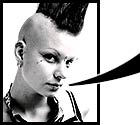 |
The only other theme that has really stayed with me as something that would have been great to do is the full body maze tattoo, but really I don’t have any interest in a different theme just improving on this design as I can.
|
 |
Plenty, although most are probably due more to laziness than true lack of time. It’s almost always lack of effort rather than time. I would really like to be better at computer programming. My juggling could use plenty of advancing beyond the simple three object patterns I can do now. I’d like to be a better unicyclist. And there is always the dream of professional pc gaming, but my skills are not on that level – yet.
|
 |
The worst I can think of is me shouting at someone in a mall. Things rarely get any uglier than me getting loud as most people will back down at the sight of an angry Lizardman. If I recall right, someone grabbed at my arm while I was eating and I responded with something along the lines of a very loud, “Do not fucking touch me.”
|
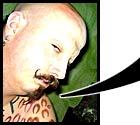 |
Are you still here? Seriously.
I hear you do good work under tables though… Orbax is Canadian for wet/dry vac. Seriously.
|
 |
In the mid to late 90’s AOL was the game in town — especially for people who traveled and wanted to be able to dial up from anywhere. Having established addresses there years ago, it is still used by many traveling performers and corollary professionals (tour managers, etc). AOL sucks and as a user I know it sucks much more than most. But all I use it for is mail and since they have recently opened up their servers so I can use other programs to access it, I hardly ever run their software. That said, I am currently looking at other options and will likely make a gradual transition to a new address over the course of this year. This is not something I or anyone else who lots of business takes lightly since I still remember how many missed and delayed messages happened when I last switched addresses.
|
 |
Um… yeah. Perhaps I should have babelfished this one..
|
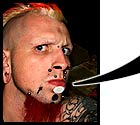 |
Most likely possibilities would have been educator, something I did do. Or a more traditional media artist.
|
 |
Burial or other rites are done for the living not the dead. I don’t much care but I will try and leave funds so as not to burden loved ones with expenses. Might be nice to die knowing that my ashes or remains baked into a cream pie would be thrown into the face of someone appropriate though.
|
Suspensions & Tensions: Today, Part I – Fakir Rants & Raves
 |
Suspensions & Tensions: Today, Part I |
TRIP TO HEAVEN, HELL OR SOMEWHERE IN BETWEEN OR BEYOND
In my last column I wrote about the history and origins of flesh suspensions and energy pulls, about some of the customs and rituals of other cultures from which we are just now rediscovering a special kind of magic. I wrote of a boy in South Dakota who was “set on fire” when he first learned of these body rites. Now I continue the path of discovery of that specific boy. Me.
In societies where suspensions by piercings are part of a spiritual tradition, these intense acts are intended to lead one to a transformative experience – an ecstatic state, a dissociation from the body where consciousness is free to explore unseen dimensions of life. It is at the same time a release into one’s own private heaven or hell, then if you are lucky, an escape from that limited state to a special kind of consciousness beyond ego. A universal spacetime shared by all. Suspension by piercings is not a toy. It is not a plaything. As some contemporary suspendees have already learned, when it is attempted as an act of bravado or show of stoicism, it can often lead to a very unpleasant and unrewarding experience. The unseen worlds do not open up. All that’s left when it’s finished are scars and a few rolls of film. For some with an impoverished ego, that may be enough. No problem. But for me it has to be more.
By the time I was ready to try a serious, long-lasting O-Kee-Pa style suspension, I had already learned to dissociate from my body and had experienced leaving it consciously (see “Against the Coal Bin Wall” in Body Play Number 4). By a series of increasingly intense and prolonged body rituals over a twenty year period, the “boy” had prepared himself for a truly significant inner experience.
FAKIR’S JOURNEY TO THE WHITE LIGHT
It began in 1962. I was thirty-two. Fate had allowed me to visit Japan. A very unlikely place for this journey to begin since my roots were on the plains of South Dakota where the mysteries of the O-Kee-Pa suspension had actually taken place a hundred years prior. In the Kanda bookseller’s section of Tokyo, I found a lost book that very few people had seen for nearly a hundred years: George Catlins’s original volume, “O-KEE-PA, A Religious Ceremony of the Mandans“. I opened the red Morocco leather and gold gilded cover. This was a rare original book published in London by Trubner & Co., Paternoster Row in 1867!! I held it in my hands and leafed through its pages. My heart pounded and my whole body began to shake. There it was, Catlin’s color lithos of young Mandan boys suspended by two piercings. How had this treasure gotten to Japan? Perhaps as a gift to some Japanese dignitary by the British, or in a missionary’s trunk? Who knows? My chances of finding this rarity were one-in-a-million, probably more. That day some force greater than myself seems to have directed me to my path up the mountain. My path to the Mandan’s White Light!
The bookseller, not knowing the rarity of this book, sold it to me for thirty dollars. Now I had an ancient guide to my destination and I lived with it constantly for the next year. The descriptions of the ceremony and the crude but vivid Catlin drawings sketched on-the-spot etched themselves into my consciousness. Only one thing mattered: I had to do the O-Kee-Pa!! But there were no living humans I knew who could show me the way. To the best of my knowledge, none of the few remaining Mandan (ninety five percent of them had been wiped out by a smallpox epidemic, a gift from the white man, in the winter of 1832) had ever done this rite in my lifetime. And I had lived among them. I was on my own and my sole guide had to be the same larger force that had mysteriously drawn me to that book on a hot August day in Tokyo, Japan.
By July 1963, I was ready for my first attempt. In the attic room of a small house in Palo Alto, California, I screwed up my courage and began the piercings. I was not prepared to pierce myself in quite the style of the Mandans – cutting deep incisions in my chest and inserting plugs. So I was guided to make deep piercings through my entire breast area, in as much flesh as I could gather up. I used some wire clamps I had made to hold the gathered-up skin in place. The piercings themselves were made by slowly screwing a long 1/16″ thick stainless wire through each breast with yet another home made device, a screw piercer (see photo). As the blunt wire tip slowly forced it’s way through my body (it took several hours to make each piercing), I went into a light trance. At this point I was glad I had fasted for two days, made other physical and mental preparations, and had opted for slow piercing.
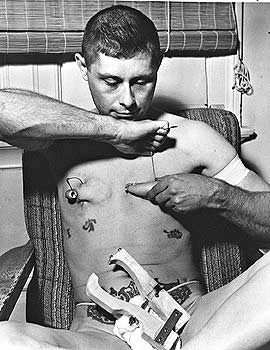 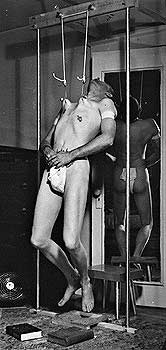 |
Left: For my first O-Kee-Pa suspension in 1963 I slowly screwed long wires deep through each breast with the homemade piercing device resting on my lap in this photo. Wires were made into loops for the hanging. Right:
In my 1963 attempt, I lowered myself from a stack of books until I hung free for several minutes. I proved my living flesh was strong enough to be safely suspended by wires.
The sensation of the slow piercing was intense but bearable. Then, not having anyone to help me, I stood on a pile of books beneath a suspension frame I had made in advance. I gradually let my weight (140 pounds then) be “taken” by the piercings. I had to be very cautious. As the Mandans had learned, and Catlin mentioned in his O-Kee-Pa book, one can only hang by two piercings in the chest for about twenty minutes. After that, strangulation begins and one can quickly die!
Somehow suspension from dual piercings in the back does not cause the same physical effect and one can hang for much longer periods.
Over the next thirty minutes I managed to kick one after another of the books from under my feet. At last I was standing on tiptoes with about 80% of my weight on the piercings. My breathing was shallow and forced. The pain was intense to the point where I didn’t think I could continue. I had “gone out of my mind” and all that existed in the universe was the glowing fire in my heart center. At that moment, I tripped my remote camera, stepped off the last book almost unconsciously and swung free. The pain stopped and I started to drift off. I knew I had to come back pronto or I would be gone forever. So I struggled mightily to get my feet back on a solid surface. I had done it, even if for only three or four minutes! I was glowing, radiant and absolutely obsessed to try again.
My next attempt was a year later, in March 1964. I went through even more demanding preparations this time – I knew what to expect. I pierced my chest again with the same kind of wires which had proven, in 1963, to be large enough to support seventy pounds each without damage or tearing. In 1963 I learned a lesson about how tough living skin really is: it proved to be ten time stronger than dead skin (leather) and extremely plastic. This time I took even longer putting my entire weight on the piercings, perhaps an hour or more. I really wasn’t aware of time when I did these suspensions. This time I was prepared for the intense fire that would burn in my chest when I stepped free. And I was determined to hang as long as I felt I could stay conscious and regain control. I really didn’t want to die… yet!
I desperately longed for a Ka-See-Ka (physical and psychic guide of the Mandans), someone to help me and watch over me so I could totally let go and not be responsible for anything including my life. Finally I did swing free for a second time. I did manage to trip my remote camera again (see photo below). And again start to drift into that pleasant warm space I had experienced when I was lashed against the coal bin wall some twelve years before. This time I hung suspended for about ten minutes and don’t really remember how I got down, or who was watching over me to keep me from harm’s way. But some how I did escape and was more determined than ever to try again with a Ka-See-Ka. And then hang for as long as it would take to enter the unseen worlds and it’s potential transformations.
The next year, 1965, I met merchant seaman and tattoo artist Davy Jones who eventually put the large blackwork tattoo I had always wanted on my back and hips. He had lived among tribal people in the Pacific; he had been ritually tattooed in Western Samoa. We developed a close friendship and spiritual connection while making my “magic mark”. I developed a deep trust in his integrity and he expressed an interest in fulfilling the role or protector and Ka-See-Ka in my next O-Kee-pa suspension. But I had to wait another two years because in 1966 I mistakenly married a woman who really didn’t understand my spiritual quest or support my unusual explorations. She preferred not to be around during body rituals.
By April 1967, I was aching to accept Davy Jones’ offer to help in an “all out”; chest suspension. Nothing would stand in my way. So I gave my wife my car keys, a credit card, and $300; she drove to Palm Springs for the weekend. Again, I spent several days preparing myself for the ordeal to follow, the total “letting go” I desired. I signed a letter to Davy Jones releasing him from all liability and responsibility in case something happened (like serious injury or death). He liked that. The evening before the suspension, he arrived along with Joe, a sympathetic friend who agreed to make an 8mm movie as documentation. No still photos would be taken. I stayed up all night fasting in tight constrictions and other deprivations. I wanted to start a light trance and dissociation from my body before the piercing.
By 6:00 AM the next morning I was ready. In a calm and deliberate way I pierced my own chest for a third time. The energy from Davy and his friend watching was supportive and comforting as I rather quickly screwed the wire rods through my breasts. There was no real pain this time; my body wanted the penetration. The flesh just seemed to part on its own and let the wires pass through. Beautiful. I felt empowered by this. We made loops in the wires, bound the ends and attached a short rope between them. Then I told Davy I was ready for my suspension. Single file we went out into the bright, crisp morning light in the yard and then into the dark and empty garage building prepared for the ritual. The interior atmosphere was similar to a reconstructed Mandan lodge I had visited in North Dakota years before.
I stood on a tall black box in the center of the large room. Davy connected the rope between my piercings to another one dangling from the beams above. Both Davy and Joe gently pulled slack from the suspension rope. I felt increasing pressure in my chest. I was slightly on tiptoe when they stopped. A wonderful feeling swept through me – waves of tingling. This was different than the last time. I relaxed into the feeling. For a long time I stood very still in the silence and darkness. My mind was letting go. My attention focused on feelings and sensations. As we had prearranged, I was to say “UP” whenever I was ready to continue. I said “UP“. Ropes creaked and slipped sending vibrations into my piercings. I threw my head back, felt myself being inched upward until I was on my toes again.
Fire came into my heart center as I let myself sag down onto the piercings. I struggled for breath. But I soon relaxed into some comfortable shallow breathing, small pants. More stillness and adjusting. I started to drift away. I was a little blob of consciousness now, just observing body sensations no matter how intense. And the observer was somewhere remote from the body. I said “UP” again to see what would happen. Instantly I zoomed back to full awareness of body sensations, pain. More stillness, patience and adjusting until I was again safely detached. On the fourth “UP” I reached my limits. With almost all of my body weight on the piercings, I had to make my last conscious decision: give up or swing free!
 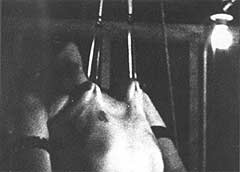 |
I hadn’t come this far to give up. I plunged off the cliff and swung clear of the box which was immediately taken away so I couldn’t change my mind. I was floating in a vast sea of vibrations and vibrant colors. Uncaring with no identity, no memories, no body. Since my head was back when I swung free, I was looking up. And there it was at the end of a short dark tunnel, a great shimmering ball of white light!! It radiated intense waves of love like I’d never felt before. This incredible love was directed at me – personal and totally non-judgmental, unconditional, accepting. I passionately wanted to be swallowed up by that Light. In rapid telepathic communication, the Light spoke. It said: “Hello. I’m you and you are Me. And I’m as close to God as you’ll ever be. I am the One who made you and I am the One who will take you back. I brought you here. Remember the book? I am always here to guide you regardless of the form in which you see me“.
I asked the Light, “Do you always appear like this?” “No,” it replied, “I appear in any form you think I can appear“. Again I asked a question, “Is there only one of you?” The Light shimmered again and answered. “Of course not. Everyone has a White Light, but all of us are One. And One of us is powerful enough to create or destroy a world or universe. Let me show you“. I cannot describe what happened then. I was led on a fantastic tour of things made and not made and music that accompanies it all into a Divine Order.
I pleaded with the Light to embrace me. It said no, do not come closer. If I was embraced, I could not go back. The Light told me I had to return to my body and work through it until my task was finished. What task? The next thing I knew, I was back in the darkened garage laying on the floor with Davy Jones and Joe by my side. They said I had hung deathlike for twenty minutes. The experience was truly “transformative”. My life was markedly different from that day forward. I was a battery on “Full Charge” and didn’t have to sleep for the next 72 hours. My mind was ultra clear and all my physical functions seemed to have been enhanced.
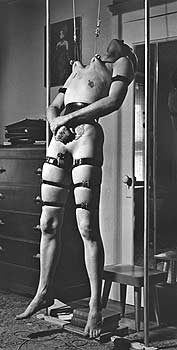 |
Left: In my solo 1964 suspension, I hung by dual piercings for ten minutes.
Right: For my fifth O-Kee-Pa suspension in 1976, I hung from permanent deep chest piercings I had made several years prior. Iron hooks are 3/8″ thick. |
The Lizardman goes to Am-Jam [The Lizardman]

|
|
"I am having so much fun performing, I feel almost guilty. I think, my God, I hope no one comes and busts me for this."– David Crosby
When I moved to Texas in late 2001, one of the fringe benefits I was greatly looking forward to was no longer having to shovel snow or de-ice my car. Why is it then that every January when NY is doing its best imitation of an icebox have I since traveled up north, back into the snow and cold?
To be part of the Am-Jam Tattoo Expo.
My connection with Am-Jam goes back six years now. It began in 1998 when an announcement for the upcoming 1999 edition of event was posted online in rec.arts.bodyart. At the time I was a regular reader and contributor to r.a.b. and having recently decided to get back into performance as a full time venture I contacted the poster – none other than then VP and now head poobah Jeannie aka “Mom”. Being so close to the actual date, things were pretty well locked down in terms of entertainment and budget but being that is was only a few miles from my apartment in Albany to the armory in Schenectady where the event was being held we struck a deal that I would come out and do a few things during the breaks in onstage activity and she would give myself and a friend or two passes into the show and some drinks. It wouldn’t be the first or last time I worked for free beer and good time.
I was accompanied out to the show by Scott, who has since gone on to become The Amazing Dr. Grift and an indispensable part of my show and business. Within moments of arriving we made fast friends with everyone there and Jeannie was soon calling us her “sons”. Throughout the day I would get onstage and do an act or two – a bed of nails, sew buttons to my arms, lift things with piercings, the blockhead, etc. It went incredibly well and the crowd loved it. This was also the source of one of my favorite all time crowd comments: “Man, that is fucked up!” The comment isn’t particularly notable in and of itself and I hear it a lot but when I heard it that day from a Hell’s Angel it meant a lot more. I was reaching people with a generally higher than average tolerance for the weird and unusual. We returned each day and did a little something every time – including a stint as the walkway for the leather fashion show with each model stepping on me on the bed of nails as they took the stage. In those three days we made lifelong friends and probably got overpaid in terms our drinking. Throughout the year we would do the same at other Am-Jam events. BME still contains galleries of some of the pictures I took, which also show a pre-implants and facial tattooing version of me:
- http://www.bmezine.com/tattoo/convent/aj99001.html
- http://www.bmezine.com/tattoo/convent/naj99001.html
Am-Jam would be a regular part of my schedule and integral part of the development of my show for the future.
Things continued on in much the same way for 2000, 2001, and 2002. These were years of great growth for myself and my show and every time we returned to Am-Jam it was like a homecoming and we did just a bit more. Am-Jam became the event where I brought media coverage to see me in action. Over the years I have been filmed and photographed there for numerous print publications including many industry magazines as well as German TV and print, National Geographic, and more. This year was no exception as I was joined and covered by a Hong Kong based magazine.
In 2003, I took on a new role – albeit briefly – as co-MC for the expo. This was also the year I met Spider Webb who was exhibiting a number of paintings and other pieces at the event. The meeting was fortuitous and resulted in not only a new friend but also a new tattoo as I became part of his “X” work by receiving an “x” tattoo under my eye. The experience I wrote for BME about the tattoo can be found here. That was the first and last year I would MC at the event and also the last year it would be held in Schenectady.
Liverpool, NY became the new home of the Am-Jam tattoo expo in 2004. And then, as before and as I am sure I will again I got in my car and drove from the warmth of Texas into the blizzards of western NY. The change of venue meant some very positive new things for the event. It was now partnered with a strong local radio station (105 The Dog) and there was a new hotel with much more space – and a full stage for competitions and performances. This was also the year that I would get my lips tattooed while there, by Miss Vicke. You can read about that here.
And that brings us to this year’s event.
The 2005 Am-Jam would be the first event in a two week run on the road for me and the show. I had hoped that we were well prepared for the trip north by our first gig of the year in Anchorage, Alaska a week prior but it was to no avail. New York proved to be colder than Alaska – by several degrees – during the time we were in each state respectively. Nonetheless, we made it through – mostly by staying indoors. We arrived on the Thursday evening prior to the event and said hello to all the family before getting some much needed rest after 30 in a rental car. Technically, it was split between two rental cars because around Cleveland our first car got a flat tire due a random chunk of metal in the road. As the show must go on, so must the car. We exchanged cars at the Cleveland airport and were back on our way.
A brief nap would be all we got before awaking to visit Scorch on the morning radio promo for the event. Before leaving for the radio station there was some local news to shoot for as well. I did an excellent job of disturbing the reporter and apparently the studio editor as my antics were mostly cut from the piece that ended up running throughout the day – still it did the job. We got back a bit before noon and had another nap before setting up the booth and opening up with the event at 6 PM on Friday night.
As might be expected for our sixth year, we had tons of familiar faces stop by and visit our booth. The snow held off for Friday but on Saturday we were effectively snowed in. It always snows during Am-Jam, but this just means you know where the party is and it’s not going to go anywhere. Saturday was also our performance day and we had a great time with equal response as always.
Sunday we made the decision to stay in the hotel through Monday which relieved of our usual need to pack up and rush goodbyes before getting on the road. We took things leisurely and enjoyed a successful show and weekend of business at the booth. That night, after shutting down it was a trip to the hot tub and strategizing for the upcoming bar show in Albany, NY and then another convention in Ohio.
There are always variables in life, especially that of a traveling performer, and sometimes the start of a new year can seem daunting but I feel assured that I can count on being at a lot more Am-Jams and every one sending me off better than the last into the rest of the year. My sincere thanks to the Am-Jam family and all friends old and new from the event that have helped make my show what it is.
![]() Erik Sprague
Erik Sprague
because the world NEEDS freaks…
Former doctoral candidate and philosophy degree holder Erik Sprague, the Lizardman (iam), is known around the world for his amazing transformation from man to lizard as well as his modern sideshow performance art. Need I say more?
Copyright © 2005 BMEzine.com LLC and Erik Sprague / The Lizardman. Requests to republish must be confirmed in writing. For bibliographical purposes this article was first published January 13th, 2005 by BMEzine.com LLC in La Paz, BCS, Mexico.



